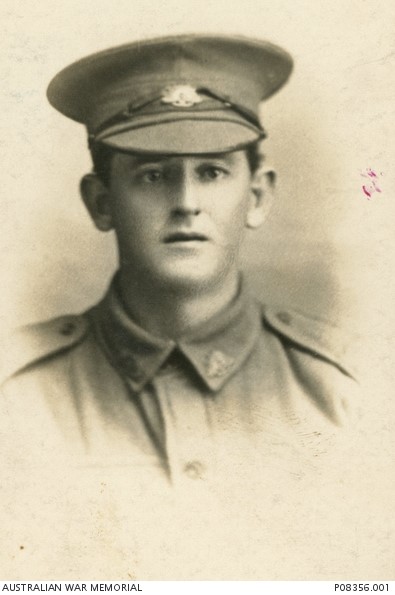34th BATTALION - 35th BATTALION AIF
Private: 730 Herbert Robert Duncan CHERRY
Born:12th September 1893. Barnsley, New South Wales, Australia. Birth Cert:36747/1893.
Married: 23rd April 1913. Minmi, New South Wales, Australia. Marriage Cert:5574/1913.
Wife: Margaret Eveline Cherry. nee: Scott. (1895-1971)
Died: 15th November 1918. Died of Disease, (Bronchial pneumonia due to exposure) France.
Father: James Duncan Cherry. (1860-1941)
Mother: Margaret Louisa Sidebottom Cherry. nee: McGuinness. (1851-1926)
INFORMATION
Herbert Robert Duncan Cherry enlisted with the AIF on the 1st February 1916 at West Maitland, N.S.W. and was allocated to 3rd Reinforcements, C Company 34th Battalion AIF. Herbert embarked on board HMAT A20 "Hororata" on the 2nd May 1916 and disembarked at Devonport was reached on the 23rd June, the Battalion disembarked at Plymouth at 1:00 pm and en trained during the afternoon for Amesbury, arriving at midnight and marching to hutments at No: 1 Camp, Larkhill. Here the Battalion settled down to hard training, which included Route Marching, Trench Digging, Bomb Practice, Musketry and General Camp Routine. Later the Battalion moved to the No: 25 Camp and finished off their training, which included six days' battle practice and field work at the Bastard Trenches.
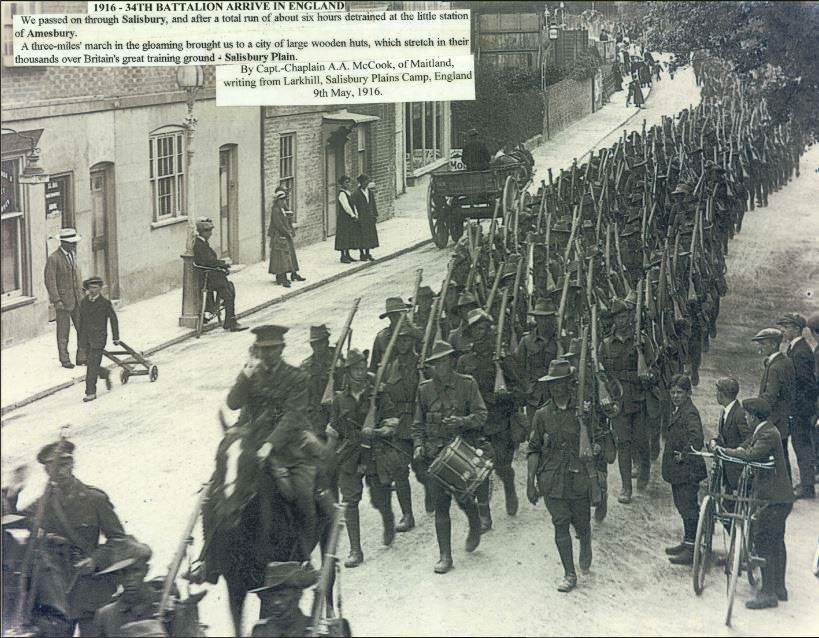
34th Battalion marching through Amesbury
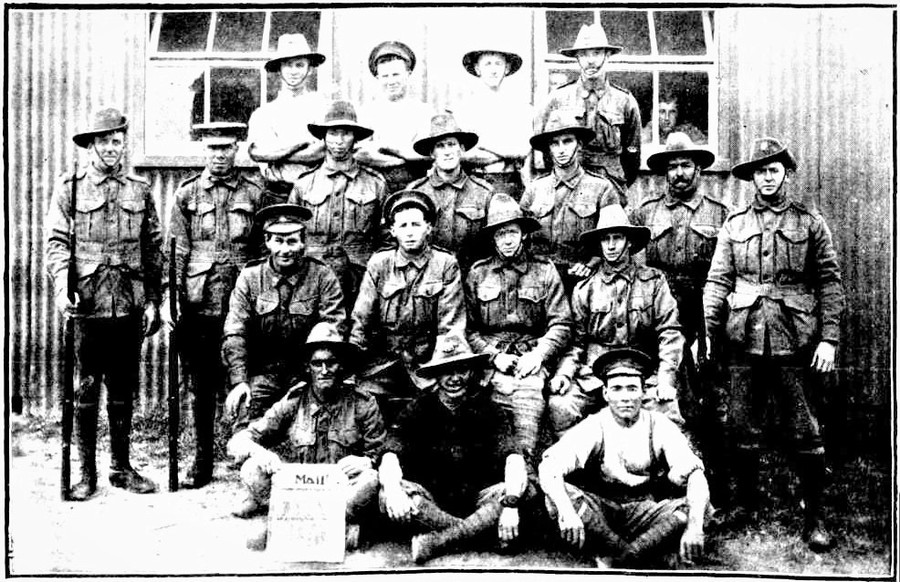
Some of the Original Wallabies – Salisbury Plain, England 1916. Section of C Company – 34th Infantry Battalion AIF.
Back Row: Private: 847 Lyle MURRAY; - Private: 903 Frank Dixon THOMAS; - Private: 774 Albert GREENFIELD; - Private: 828 James Muir LECKIE.
Third Row (standing): Private: 902 Christopher THOMAS; - Private: 875 Patrick PORTER; - Private: 751 Lial Edgar EDWARDS; - Private: 845 Robert MURRAY;
Private: 806 William Adolphus JOHNSTON; - Private: 716 Edward Mark BLATCHFORD; - Private: 730 Herbert Robert Duncan CHERRY.
Second Row (seated): Private: 756 Fred ENGLAND; - Private: 920 George Alexander WOODS; - Private: 769 James GRAHAM; - Private: 797 Charles William INGRAM.
Front Row: Private: 838 William David MORGAN; - Corporal: 713 John BELL; - Private: 793 Victor HUDDLESTON.
The 34th Battalion left Lark hill on the 21st November and en trained at Amesbury for Southampton, embarking on the S.S "Arundel". The transport section left by S.S. "Princess Victoria". The Battalion arrived at Le Harve, France on the 22nd November 1916. Disembarkation commenced at 8:00 am and the Battalion marched to No;1 camp on the Hill, arriving at 2:00 pm. The men carried heavy loads, in some cases amounting to miniature Q.M.' Stores. The march over cobblestones was very tiring, notwithstanding the many route marches which had been carried out at Larkhill. However, after bathing their feet and receiving treatment, as well partaking of a good meal, some spent a comfortable night.
The 34th Battalion relieved on the 12th February and until the 17th February, the usual routine of supplying Working Parties, general cleaning up, was carried out. The 34th Battalion went into the Line again from the 18th to 25th February and Patrols were busy exploring No Man's Land. The enemy Patrols and Working Parties, which were strong, were dispersed by Lewis Gunners. Snipers were very active and the enemy Machine Gun fire greatly increased. From the 25th of February the 34th Battalion was in Billets.
34th Unit History.
Herbert was treated for an Abscess on his Thigh and was admitted to Hospital for treatment and was discharged back to his unit on the 18th of March and was sent to Grenade School the next day and after completion of his training re joined his unit on the 26th of March 1917.
6th June 1917.
BATTLE OF MESSINES
At 10 pm on the 6th June 1917, the Battalion left its billets fully equipped for the assembly Trenches. The order of march being "D", "A", "C" and "B" Companies. All went well until just before reaching Gunners Farm, where the enemy was putting a number of Gas Shells over and Masks had to be put on. Ploegsteert Wood and the back area were receiving particular attention. All Companies were greatly delayed of the amount of Gas in the Wood, which resulted in a number of men being gassed on the way up and many others were completely exhausted. A number of men lost there way in the darkness and smoke. Many could not see at all and had to be led back by there comrades. I many cases it was the blind leading the blind. After a gruelling March, the first arrivals reached the Assembly Points 30 minutes before Zero Hour, while the last company arrived only 10 minutes before Zero.
On the 7th June, seven seconds before Zero Hour, which was 3.10 am, four Miles on our front were fired. There was a violent swaying as if an earthquake had taken place and the men in many instances were thrown together. The sky was brilliantly illuminated by the explosives and terrific Artillery fire, the sound of which could not be heard over the intense Machine Gun Barrage. The men left the Trenches immediately and there were a number of casualties on the parapet owing to the heavy enemy Barrage. The supports were also being shelled and the Reserve Company ("D") suffered considerable losses. The weather was hot and sultry and every one felt the tiring march.
The Battalion passed through the 35th Battalion in the vicinity of the enemy's original Front Line, near Ulsters Switch. The enemy fire had been very severe up to this point and many men were lying here. A halt in our Barrage gave the Company Commanders an opportunity of Checking their Compass Bearings, defining their limits, and getting into position for the next advance. At the left of the Barrage a fine assault in complete waves was made. The men gained their objective in fine style behind a perfect Barrage and commenced consolidating their position. The mopping up of the Trench System was soon accomplished and many of the enemy were killed in their Dugouts. By 5.30 am fair cover had been obtained on the Consolidation Line. At 6.30 am Enemy Machine Guns were located in a rebut in "Uncertain Trench" and heavy Artillery was brought to bear on them with good results. By 7.30 am the Black Line was down to two thirds of its depth and linking up by Companies and Platoons were in progress. The enemy was seen moving along "Uncertain Trench" and also reports were received from the 33rd Battalion that the enemy was massing 1,000 yards in front. Reports of enemy movement continued throughout the early part of the morning, but Artillery co-operation helped to disperse the tendency and during the day no organised counter attack was attempted.
At 8.30 am the Line was well dug along the Front and affording excellent protection for the men. By 9.30 am only one gap remained between "A" and "B" Companies in the full length of the consolidation of the "Black Line" to the River La Douve. The Trenches being now well down, widening and sandbagging were now in progress and at 11.30 am showed very plainly in an Arial Photo as a good defensive Trench. There were repeated enquiries for water from the Front Line. Carrying Parties were suffering heavy casualties and were completely knocked up with the long distance.
At 1.40 pm Captain: Arthur Sidney WHITLOCK with "D" Company advanced to the Green Line, without Artillery support, owing to an alteration in the Zero Hour not reaching him. At 2.45 pm he reported by Runner that, having waited 30 minutes and no Artillery Barrage as arranged have been put down, he had advanced to the Green Line and was consolidating. by 7.30 pm all Companies reported that their positions were well consolidated. Just before midnight Captain: Arthur Sidney WHITLOCK was killed between the Green and Black Lines, and Captain: Robert Joseph STEWART took command of "D" Company. Patrols under the Scout Officers were sent out during the night and encountered enemy Patrols which were dispersed. A number of enemy patrols were also killed by our Machine Gun and Lewis Gun fire earlier in the night. At 5.00 am on the 8th June an enemy Plane over, flying low and inspecting our new position.
Our casualties to date had been 8 Officers and 236 other ranks. Captain: Arthur Sidney WHITLOCK and Lieutenant: 584 Leslie William Roy WARNER K.I.A. Lieutenant's Lieutenant: William Walter MATTHEWS Lieutenant: Hector Reginald McLEOD, Lieutenant: Bruce Gray McKENZIE, Lieutenant: Benjamin Greenup BRODIE, Lieutenant: Thomas Clifton PITTAWAY and Lieutenant: Frederick Winn WALKER wounded.
During the morning the enemy put over a heavy Barrage of 7.7's and 4.5's. Captain: Robert Joseph STEWART sent a message by pigeon that our own Heavies were dropping a few Shells short and doing some damage to our own Trenches and causing a few casualties. Several messages were sent back but it was some time before the matter was rectified. At midday enemy Machine Gun Fire from the vicinity of Potterie Farm, about 300 yards from our Front, was very troublesome. At 4.00 pm our Artillery opened up a heavy bombardment which continued for four hours. This was replied to by the enemy at 8.30 pm and was particularly heavy north of La Douve. Ten minutes after this opened all communication lines were cut and messages were sent on the Power Buzzer. By 10.40 pm everything had become normal and the night was fairly quiet.
On 9th June 1917, Lieutenant: Clarence Smith JEFFRIES. with a Patrol of 50 Other Ranks left our Trenches at 4.00 pm with the object of reconnoitering Potterie Farm. This Patrol came under heavy Machine Gun fire and on returning reported the position was fairly strongly held. Lieutenant: Clarence Smith JEFFRIES. was wounded, 2 Other Ranks killed and 3 wounded.
Private: 192 Edward Rolfe "Robert" SPINKS. Killed in Action.
Private: 2640 Clive William QUINN. Killed in Action.
On the night of 12th June the Battalion moved out to Vauxhall Camp and here reinforced by reserve men from Morbecque. The whole operation had been most successful, in spite of the difficult approach March, caused by the wearing of Gas Masks and the darkness of the night. About 3.30 am an unusual occurrence happened when one of our Planes, flying low for observation, was struck by one of our Shells and was cut in halves. During the whole period rations were taken up as usual, the limbers and Carriers being constantly under heavy fire. Many brave deeds were performed and a number of Officers and men were recommended for decorations which were in many cases awarded later. Total casualties were 10 Officers and 399 Other Ranks.
On 14th June the Battalion moved to billets near Vieux Berquin for rest and training. The next day the Corps Commander, Lieutenant General: Sir Alexander John GODLEY inspected the Battalion at Doulieu. Captain: Charles Edwin Woodrow BEAN Australian War Correspondent, was also present. The following day General: Herbert Charles Onslow PLUMER, Army Commander, interviewed the Officers and addressed them. The weather was fine and the men had a good time bathing, writing letters and resting, while reorganization and training was carried out.
34th Unit History.
Herbert was again treated in Hospital and re joined his unit only to be treated again the the 9th Australian Field Ambulance who transferred him the the 3rd Australian Dressing Room Station where he received further treatment and was transferred to Hospital. He re joined his unit on the 7th August.
The Battalion left Aldershot Camp on the 15th August and marched to Bailleul Station to en train for Wizernes. From here a lone march was carried out to Vaudringhem. this was a quite village and with its peaceful farms and green fields was a very pleasant change from the chaos of the Battle Area. The Billets were in old farm houses and the men trained with zest and Sports were held twice weekly. New formations were practiced and everyone was made ready and fit to again meet the enemy and defeat him.
on the 27th August Brigadier-General: Charles ROSENTHAL took over the Brigade from Brigadier-General: Alexander JOBSON. Brigade and Divisional Sports and also Cooking Competitions were held. Leave was granted to Boulogne and the men were able to have a swim in the sea. A picnic by motor lorry to Boulogne was arranged and the men waited two hours with towels, when the word came through that it had been cancelled owing to shortage of lorries. Much to their disappointment, as other Battalions had made the trip.
On 26th September the Battalion left Vaudringhem at 6 a.m. and proceeded via St Pierre, Elnes, lumbre, Wizernes, Blendecques, Heuringhen to Coubronne. The Billets were very scattered over the villages of Coubronne, Islinghem, Le Rons, Blamart and La Sablon. It was a long march of 21 miles and the men were very tired, but fortunately the weather was fine and warm. The following day the Starting Point at 4 a.m. the March was continued at via Quiestede, Wardrecques, Eddlinghem, Staples, Oxlaere, St Marie Cappel, St Slyvestre, Eecke to Godewaesvelde, arriving at 7.30 p.m. The men were done up after covering 23 miles, and glad to spend the night resting. On the 28th September at about 8 a.m. a large barn near "B" Company Headquarters and the Q.M. Store caught fire and a considerable amount of straw and the roof were burnt, what caused the fire was never discovered but eventually the Battalion paid for the damage. Later that day the March continued to Winnezeele via Steenvoorde, a distance of 8 miles, in lovely weather.
On 29th September the Battalion left for Zonnebeke. According to arrangements the C.O. and Adjutant went forward to the Line followed by specialists who were taken by motor bus to vlamertinghe and then marched to the Line via Menin Gate, Ypres and Railway Wood, where guides were met. The remainder of the Battalion went by motor bus via Abeele, Poperinghe, Dickebusche to Vlamertinghe and then marched into the Line. Our Front was from Brick Kiln south of Zonnebeke Station to Vanisackers Farm. The 35th Battalion being on the right and the 36th on the left. The Units relieved were what remained of the NORTHUMBERLAND FUSILIERS GORDON HIGHLANDERS, ROYAL WELSH FUSILIERS and KINGS OWN REGIMENT. The Q.M. Store and Transport proceeded to Brandhock and the "B" Teams to Morbecque.
The Battalion Headquarters was at Low Farm. Aircraft was very active and the enemy heavily bombarded to Ypres-Zonnebeke Road apparently searching for our Artillery position. A quantity of Mustard Gas Shells were fired into Railway Wood and the Frezenberg Ridge. The enemy bombing Planes were constantly dropping bombs on all camps and roads, taking advantage of the clear moonlight nights. On 30th September our Support Line was subjected to heavy shelling by 7.7's, 5.9's and 4.2's at 9.30 p.m., which gave a cable burying party an intense strafing, resulting in 51 casualties.
On 1st October the enemy put down a heavy barrage of 5.9's and 4.2's on "A" Company from 7 a.m. to 9.30 a.m badly knocking about our half made Trenches. 2nd Lieutenant: 11921 Stanley Robert CALLAGHAN. was killed and there 53 casualties among the Other Ranks. Enemy Planes were flying low over our Lines and Machine Gunning the Trenches.
On 3rd October at 8.30 a.m. the enemy shot up Potsdam, Bowry Farm, Low Farm and Frost House with H.E., but no material damage was done to the Battalion. Relief by the 10 Brigade took place that night and the Battalion marched back to the Ramparts of Ypres, after having had a strenuous time in the Line. However the enemy Planes were busy bombing Camps, Roads and Transport and many casualties were suffered. On 4th October at 10.30 a.m. the Battalion marched from the Ramparts to No:16 Central Camp, south of Ypres, a tent camp, arriving at noon. The move was made after a successful attack had been carried out at 6 a.m. by the 10th and 11th Brigades. A working Party of 100 men which had been sent to prepare an Artillery Road to Seine House, was badly shot up at 4.30 p.m. and had to cease work. The enemy Planes that night, again active over our Camp, dropping their quota of Bombs.
On 5th October the Troops were moved by Motor Bus to Winnezeele and reached Camp at 7.30 p.m. The Transport and Q.M Stores marched in at midnight from Brandhoek. The motor lorry conveying the Packs capsized in a ditch, but they arrived during the early morning. The "B' Teams marched in from Morbecque. Cleaning up and organising for the 3rd Battle of Ypes was carried out during the four days spent at this Camp which consisted of Tents. On 10th October the Battalion moved by Motor Bus to the Camp Area at Calvry Farm, East of Ypres, arriving at 9 p.m. and spent the night in the open as no arrangements had been made for Billets. Some difficulty was experienced in getting to the allotted area, as the night was dark and each party arriving would make for the nearest flame of a Cooker. However by 11 p.m. the men had been fed and were doing their best to settle down in the open in spite of the heavy rain and cold as well as enemy Bombs. The enemy on the crest of the hill ahead of Passchendaele must have plainly seen the fires in the Cookers and anticipated activity in this area, as early the next morning Planes were over taking in the general situation.
On 11th October the Second in Command an other Officers reconnoitred the ground of attack for the following day. The weather was still showery and misty and the men rested while the Band played selections during the day. Lieutenant: 4 Thomas Clifton PITTAWAY, Scout Officer, and Company Officers went up during the afternoon to lay tape and were heavily shelled. The men were given a good tea, after which the various equipment for the operation was issued to them.
BATTLE OF YPRES
The Approach March commenced at 6 p.m. from Cavalry Camp to the jumping off Line, the assembly Point being the Junction of Zonnebeke-Roulers Railway Line and Cemetery to the South West corner of Augustus Wood, thence to assembly Road along Roulers-Ypres Railway Line. The march was carried out without loss for about 7 Kilos, although the going was extremely difficult due to the rain and shell-holed state of the track, until Zonnenbeke Station was reached. From here to the Assembly tape the Battalion was subjected to heavy shell fire, principally 7.7's and 4.2's in many places the track had been blown up and the tape had disappeared. however in spite of this and casualties sustained, the Assembly Point was reached by 2.45 a.m. on 12th October, but some of the men were still arriving at Zero Hour. The heavy shelling of 7.7's and 4.2's continued during the Assembly and right up to Zero Hour, the greater part of which appeared to come from the South and South end of Passchendaele. Our casualties were very heavy, principally on the right flank near the cemetery and mostly occurred in "A" and "B" Companies.
The Brigade was formed up on the jumping off tape in the following order- 34th,35th and 36th Battalions. The 35th and 36th Battalions suffered heavily and were badly shot up, as the shells were passing over the 34th Battalion and were falling the the rear of the Battalions. At 5.25 a.m. our Barrage came down, but was so weak that in many cases was difficult to determine which was our Barrage and which was the enemy's. This made it hard for the men to keep up with Barrage, however the greatest obstacle met in the advance was the condition of the ground, particularly on the left flank of "C" and "D" Companies. There were many men lost altogether in the mire. The pace of the advance was slowed up owing to the assistance it was necessary to give men who had sunk into shell holes and could not extricate themselves without assistance.
The action of the 9th Division advance to the starting line to commence the dawn attack at Passchendaele I on 12th October 1917, through the German gas barrage called "Moondnacht", in pouring rain and pitch darkness, only to find the line was not secured. Captain: 1263 Telford Graham GILDER and Captain: Clarence Smith JEFFRIES commanding the leading companies of the 34th Battalion, halted their companies ?at the entrance to the Broodseinde railway cutting, and themselves went forward to make sure that their column might not run into the enemy.?
In a number of cases the helpers became engulfed in the awful morass and many of the wounded had to be left where they fell. The first organised opposition met with was two concrete Pill Boxes, East of Augustus Wood and North East of Seine House. These help up the center of the advance until Captain: Clarence Smith JEFFRIES. organised a Bombing Party and succeeded in rushing and capturing the Strong Point, taking 35 Prisoners and Four Machine Guns, 150 yards in the rear of this Dugout was a small Trench, about 50 yards long, in which were 20 or 30 of the enemy, who were accounted for as the Wave passed on. Throughout the advance to the Red Line heavy Machine Gun Fire was encountered from the direction of Belle Vue and Meetchiele on the left flank, and from Tiber and Tiber Copes on the right flank in the Railway Embankment. The position was also mopped up as the Wave went forward. On reaching the Red Line the Battalion began to dig in, but was greatly harassed by fire from Machine Guns situated on the right flank, about 200 yards from Railway Embankment. Captain: Clarence Smith JEFFRIES. again organised a Party of 2 N.C.O's Sergeant: 21 James BRUCE Corporal: 2036 Vere "Vic" Cumming STEVENSON. and 10 men to capture this Post. Unfortunately this brave Officer was killed in the attempt. For this action we was posthumously awarded the VICTORIA CROSS
The N.C.O's Sergeant: 21 James BRUCE and Corporal: 2036 Vere "Vic" Cumming STEVENSON. carried on and captured the Post in a gallant fight, taking two Machine Guns and 40 Prisoners. Casualties all along had been very heavy and the 35th and 36th Battalions had also suffered severely. It was decided to send all the men of the 34th Battalion to assist in the capture of the Blue and Green Lines. Captain: John William RICHARDSON. of "D" Company succeeded in reorganizing the Battalion and took them forward to the Blue Line, where he was killed. Tiber Copse caused considerable trouble, but was taken by organised Parties of the 35th and 36th Battalion, augmented by the 34th Battalion. On reaching the Blue Line, the Parties commenced to dig in and were subjected the whole time to heavy Machine Gun Fire from Belle Vue and Meetchiele, in addition to heavy Barrage Fire from the enemy Artillery.
At 3 p.m. the word was received that owing to the severity of hostile Shelling and Machine Gun Fire the Line was withdrawing. Instructions were immediately sent to hold the Line at all costs and to endeavour to refuse the left flank. Under murderous fire and vilest conditions a new Line was constructed from Deine Crossing on the Ypres-Roulers Railway, north to the direction of Waterfields. In advance to the Red Line all the Officers of the Battalion had been killed or wounded with the exception of three, who became casualties before reaching the Blue Line. Therefore the bulk of the organisation fell on the shoulders of the N.C.O's, who, although suffered heavy casualties, did remarkable fine work. The Trench Mortars took no active part in the Battle. One Mortar was blown out before reaching the Assembly Line and owing to the difficulties of the ground the Ammunition Carriers of the other did not arrive.
The Machine Gunners found it impossible to carry their Guns forward and they did not arrive at the Assembly Point until some hours after Zero. The general condition of the ground over which the men had to travel and attack was one of the two primary causes for non-success of the operation. Never before had the men been called upon to fight under such awful conditions. It was simply a mass of mud and water across the entire Front. A succession of water-filled Shell holes, which not only reduced the rate of advance but bunched the men together in their attempt to find a track around the shell holes. This gave the enemy a splendid opportunity to use his Machine Gun. The barrage throughout was very weak, no doubt caused by the extreme difficulty experienced in getting the Guns and Ammunition forward owing to the terrible state of the ground. Thus many enemy Strong Points which otherwise would have been put out of action, were left to take active participation in the fight. Belle Vue on the left flank gave the enemy a magnificent field of Fire across the whole Brigade Front. Failure may have been turned to success if the Reserve Battalion (33rd Battalion) had been brought up and used to reinforce the other Battalions. Undoubtedly this would have been of great assistance on the Blue Line, in refusing the left flank and may have saved a withdrawal.
During the initial attack Battalion Headquarters were established at Seine House. An arrangement which worked well proved economical for Signallers and Runners throughout. the following day, 13th October, the enemy kept up a heavy concentrated Artillery Fire over the whole area, apparently having no idea of the actual position of our troops. Seine House and the Regimental Aid Post at the Railway Line were subjected to particular heavy fire and many casualties occurred at both places. Major: Gother Robert Carlisie CLARKE. M.I.D(Regimental Medical Officer), was killed by a shell which fell right among the wounded who were being dressed in the open. Major: Gother Robert Carlisie CLARKE. M.I.D fell dead across an Officer of the 37th Battalion, whose wounds he was dressing. A number of Ambulance Medical Corps staff were also killed and wounded by the same Shell.
34th Unit History.
Herbert was treated by the Australian Field Ambulance on the 13th October and sent him the the Casualty Clearing Station where was transferred to the 47th General Hospital at Treport suffering from Myalgia. He was discharged from Hospital and later granter leave in England from the 21st January until the the 5th February and re joined his unit the next day. Herbert was transferred to the 35th Battalion on the 22nd February 1918 and Taken on in Strength in the field. He was detached to Armourer School on the 4th of June but was treated by the 11th Australian Field Ambulance who had him transferred to the 3rd Australian General Hospital on the 14th November suffering from Bronchial Pneumonia and he died of Disease the next day.

Grave of Private: 730 Herbert Robert Duncan CHERRY. (1893-1918)
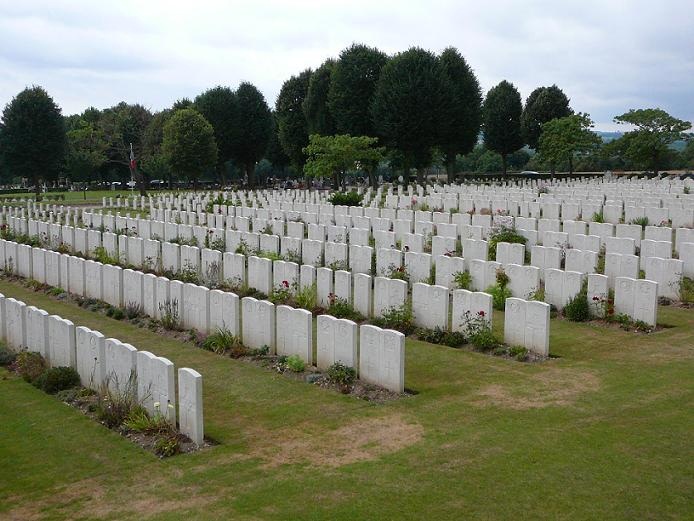
Abbeville Communal Cemetery Extension
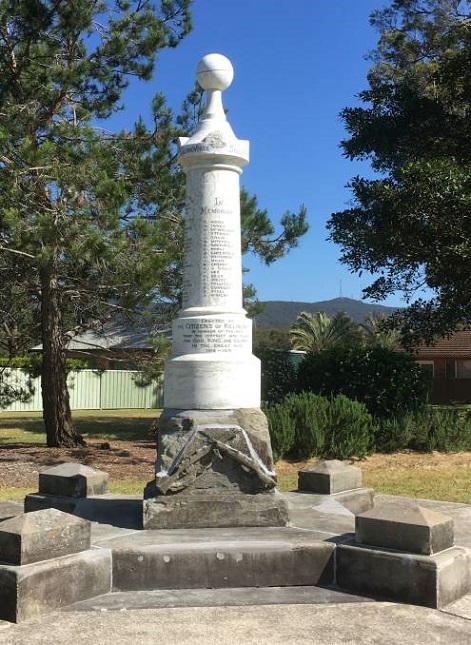
Killingworth War Memorial
Family Information
Herbert was a married 22 year old Labourer from Killingworth, N.S.W. upon his enlistment with the AIF.
Military Records
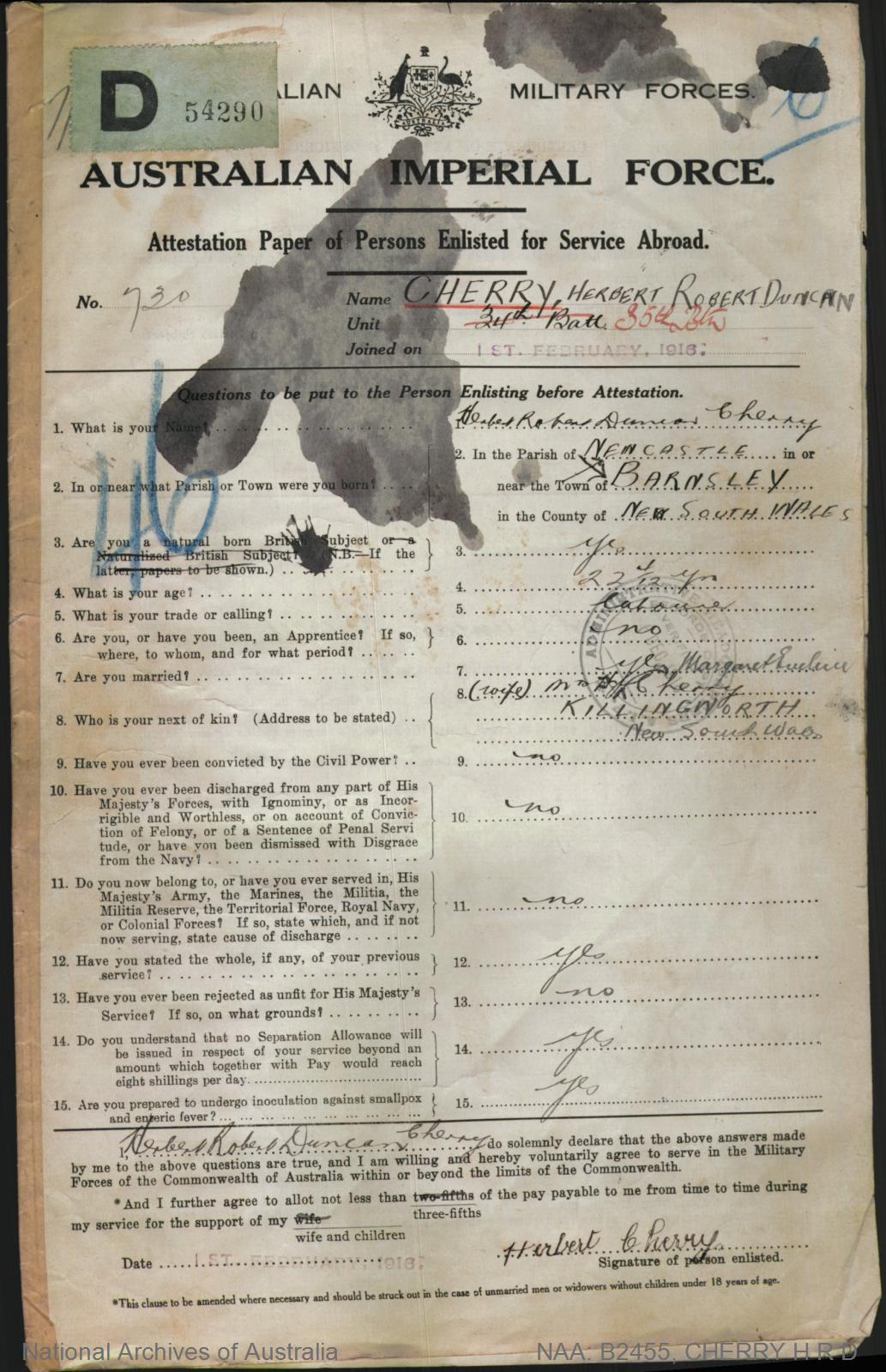

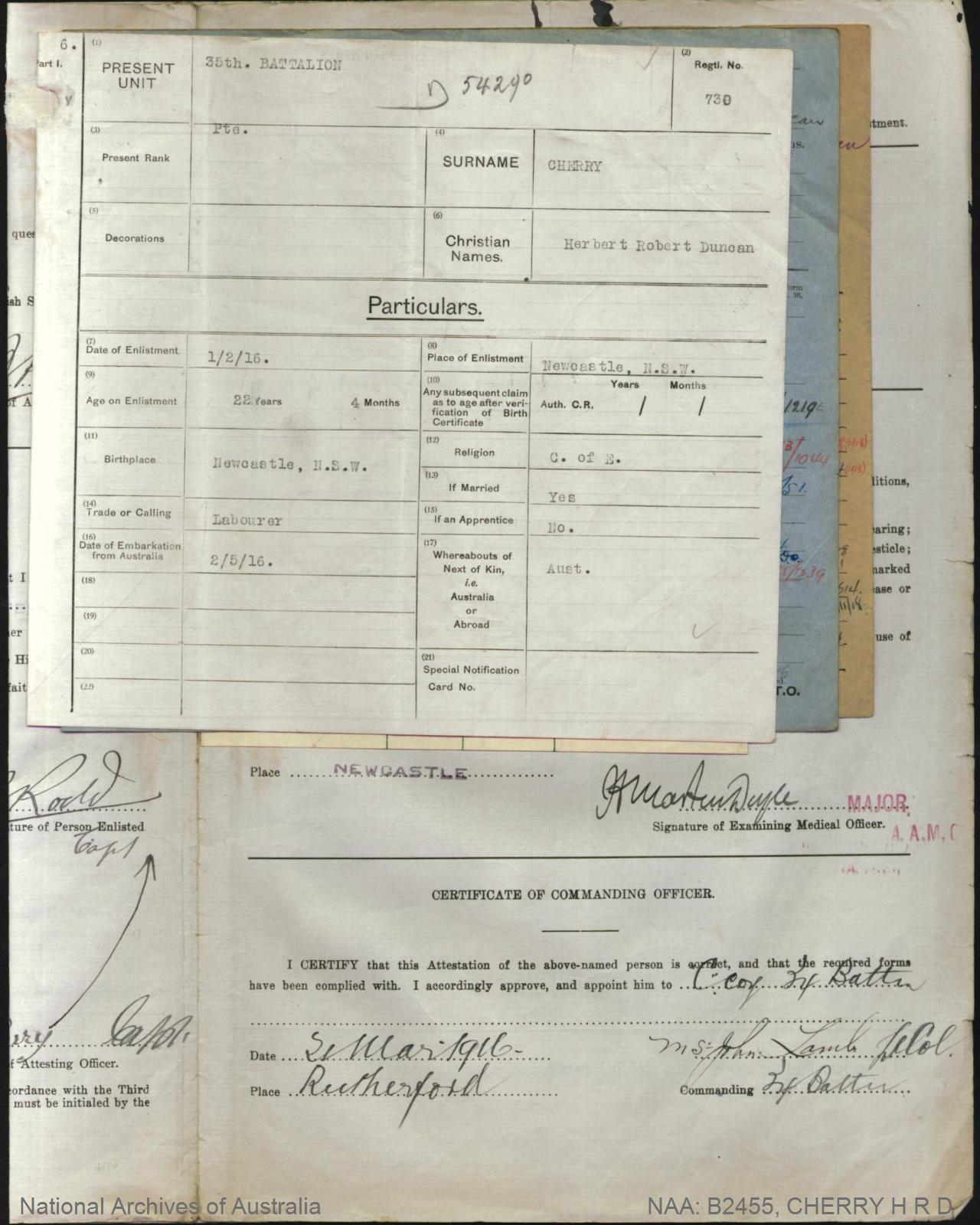

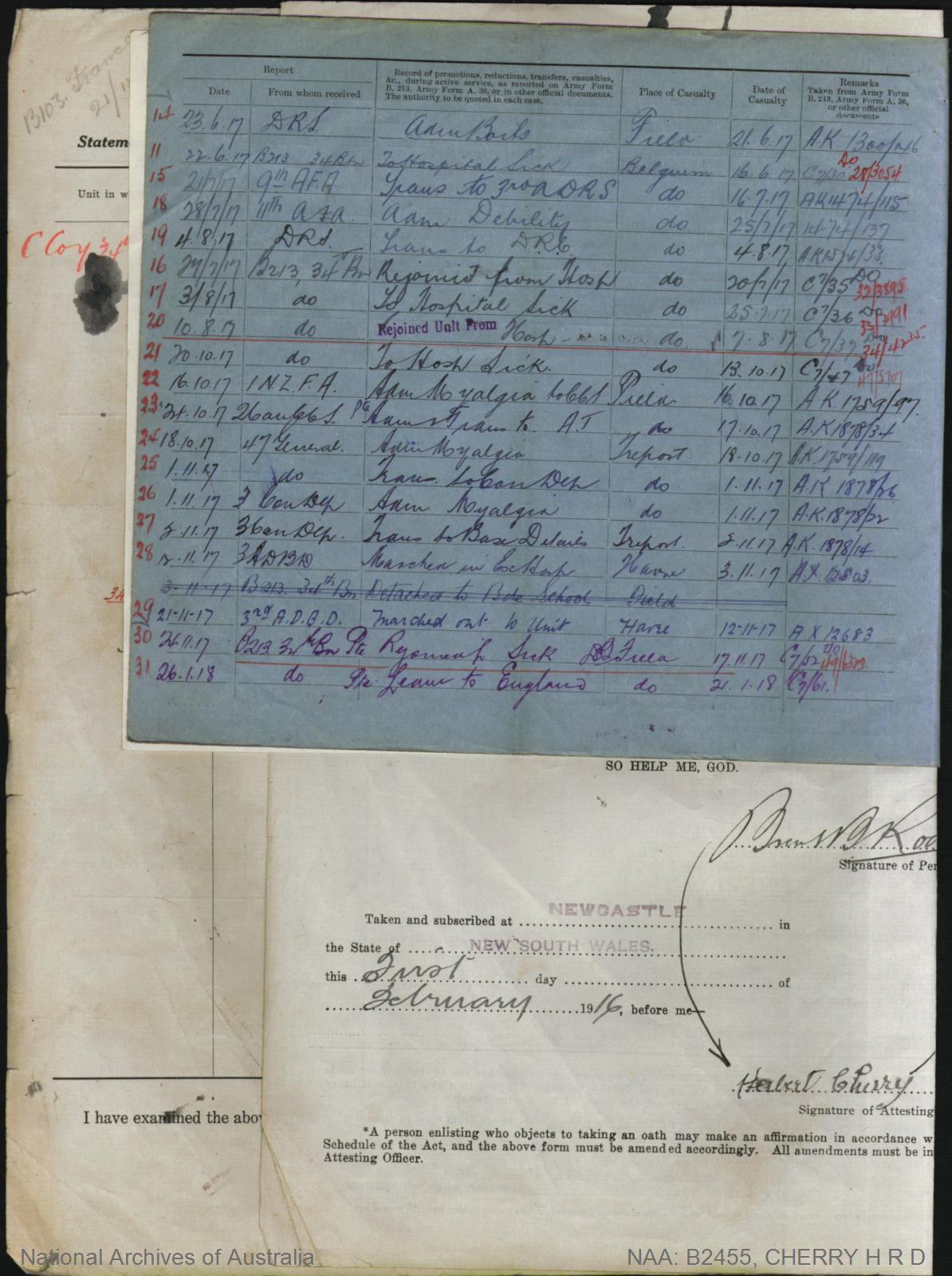
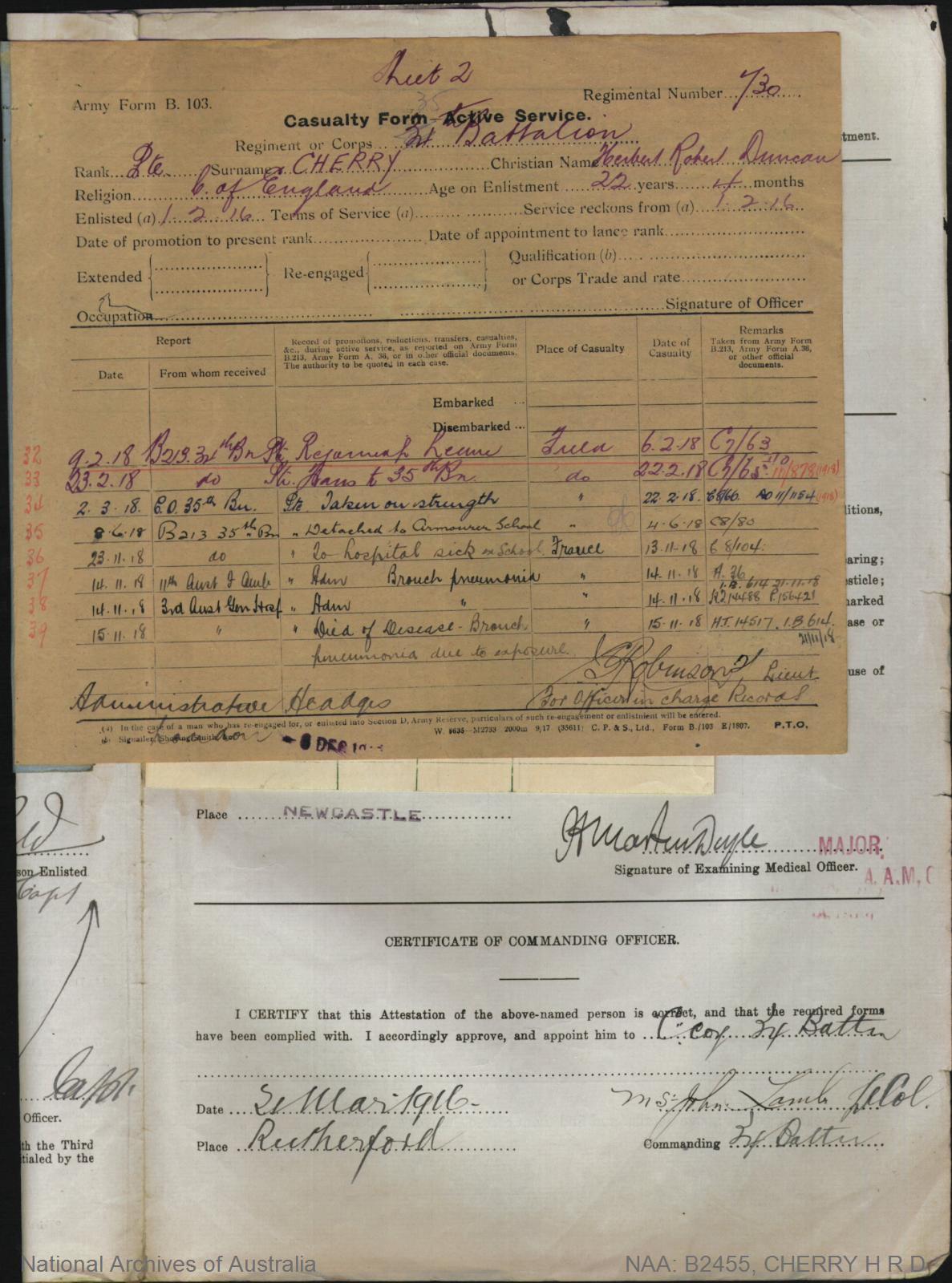
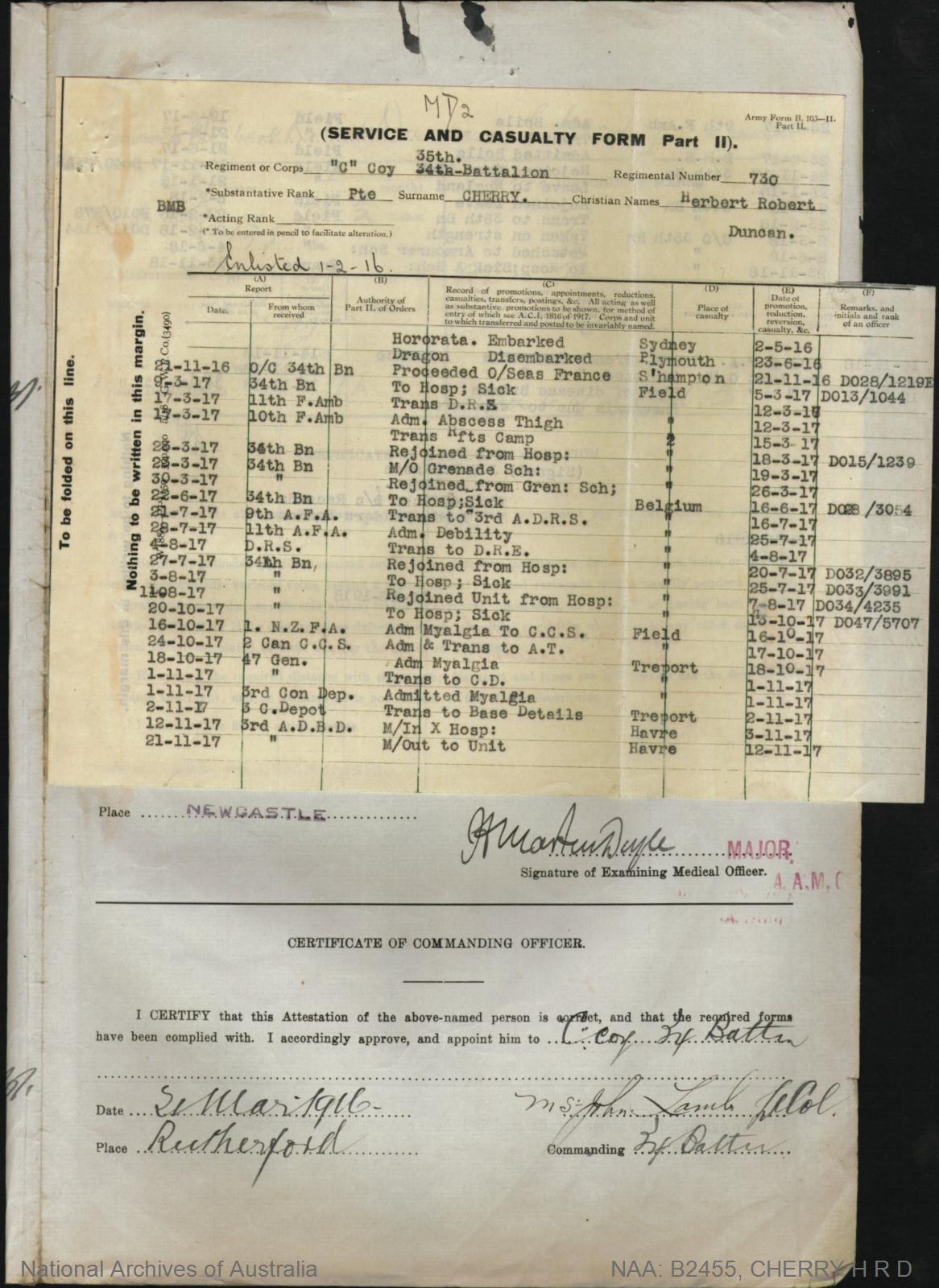
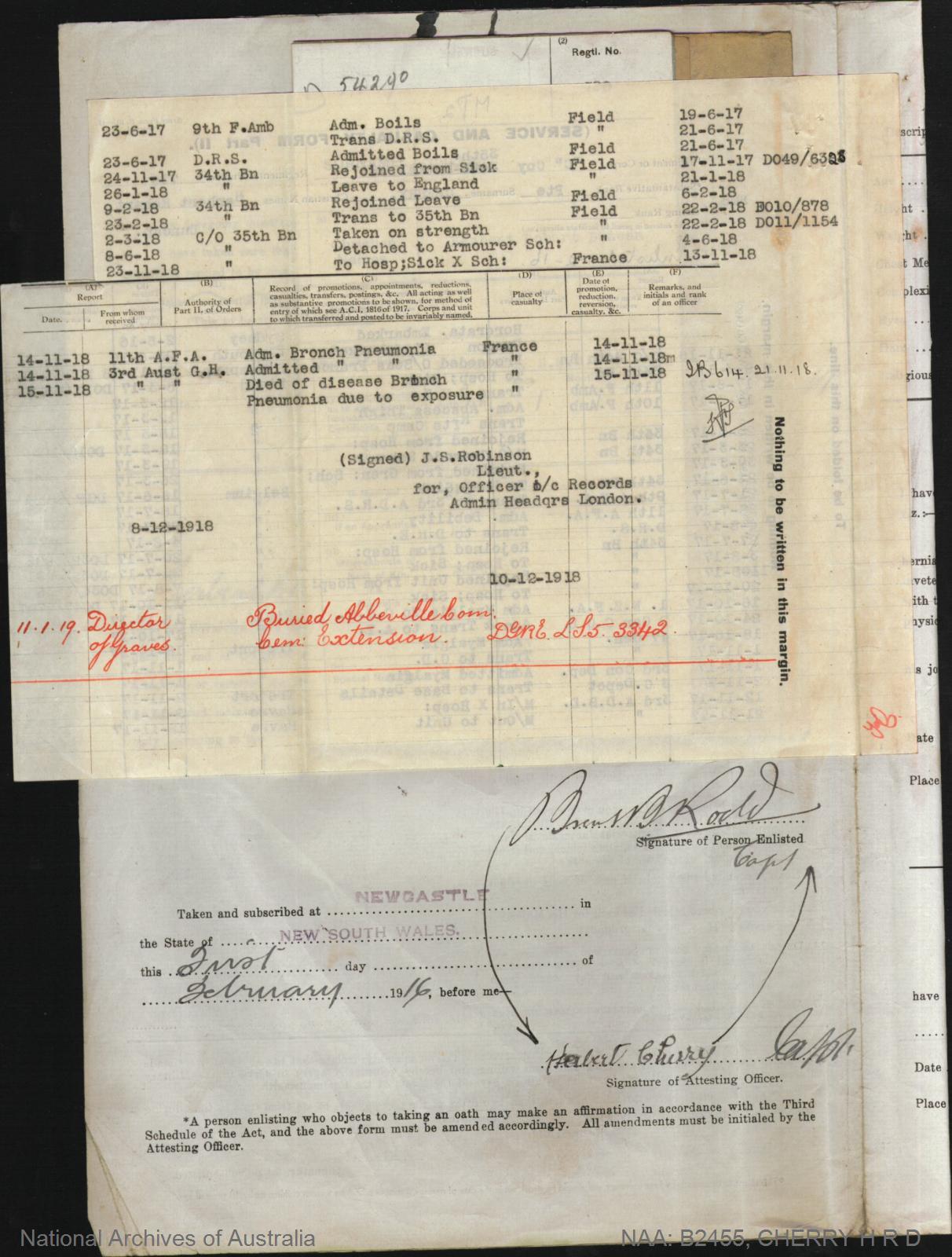
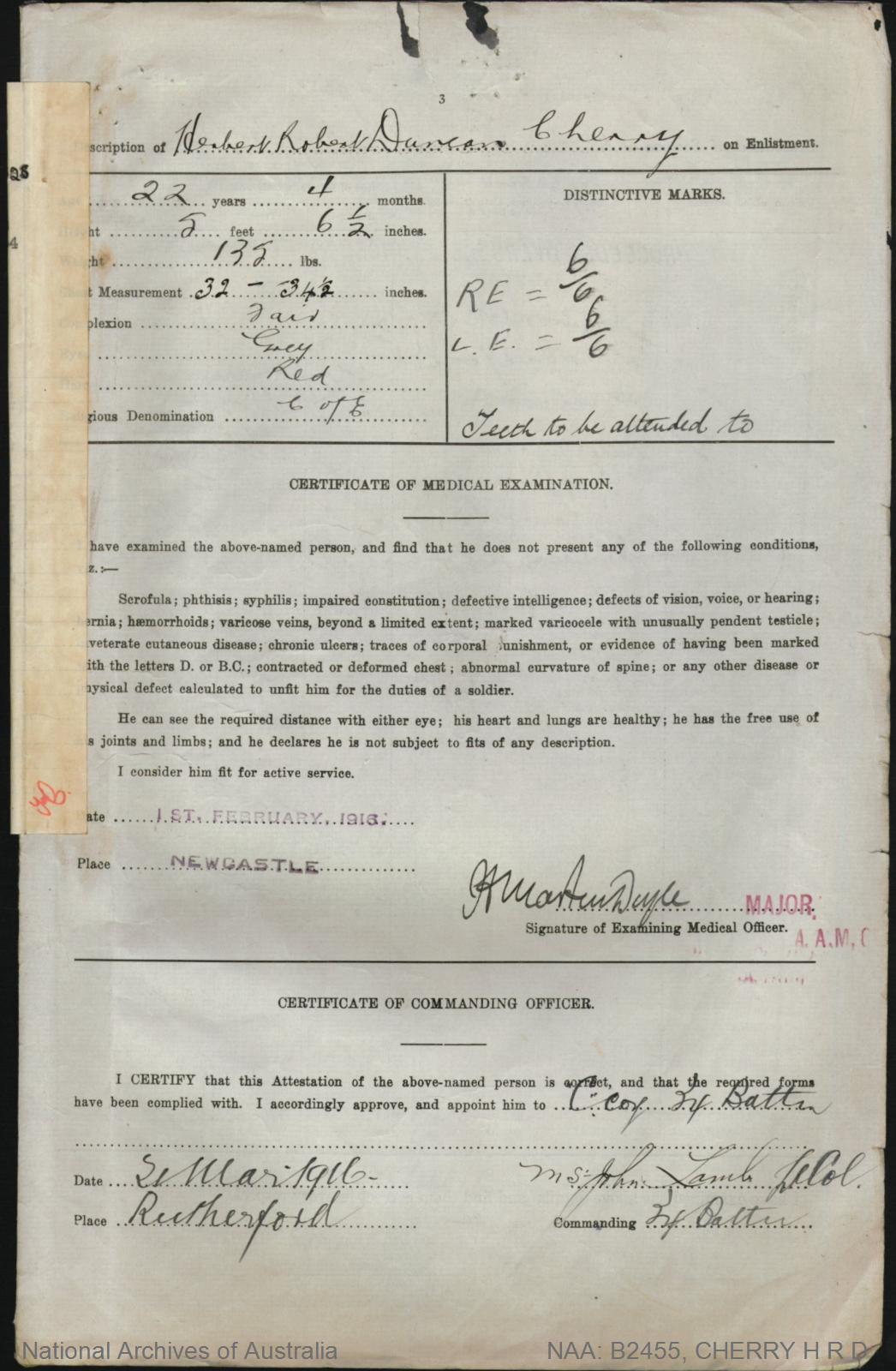
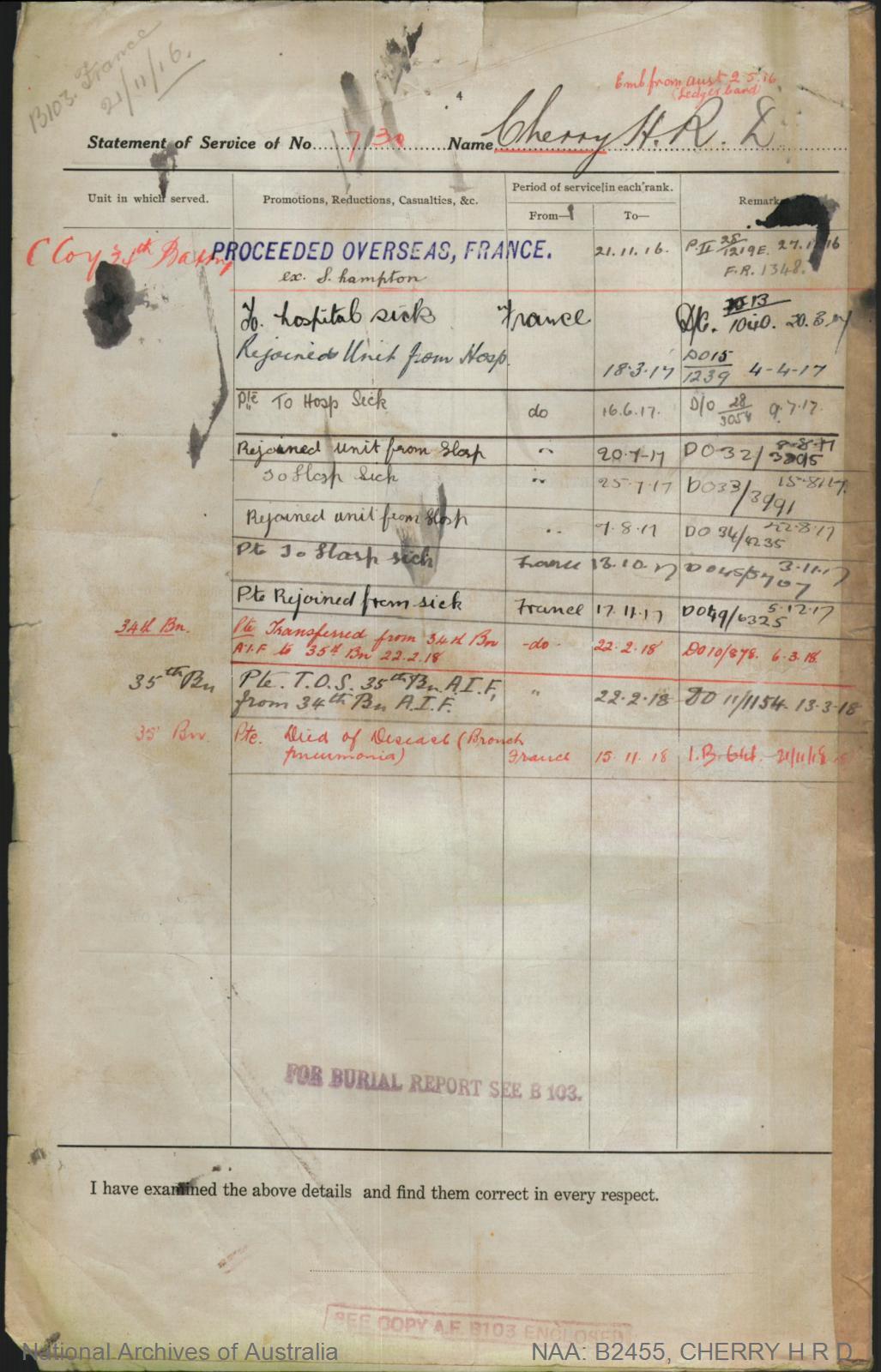
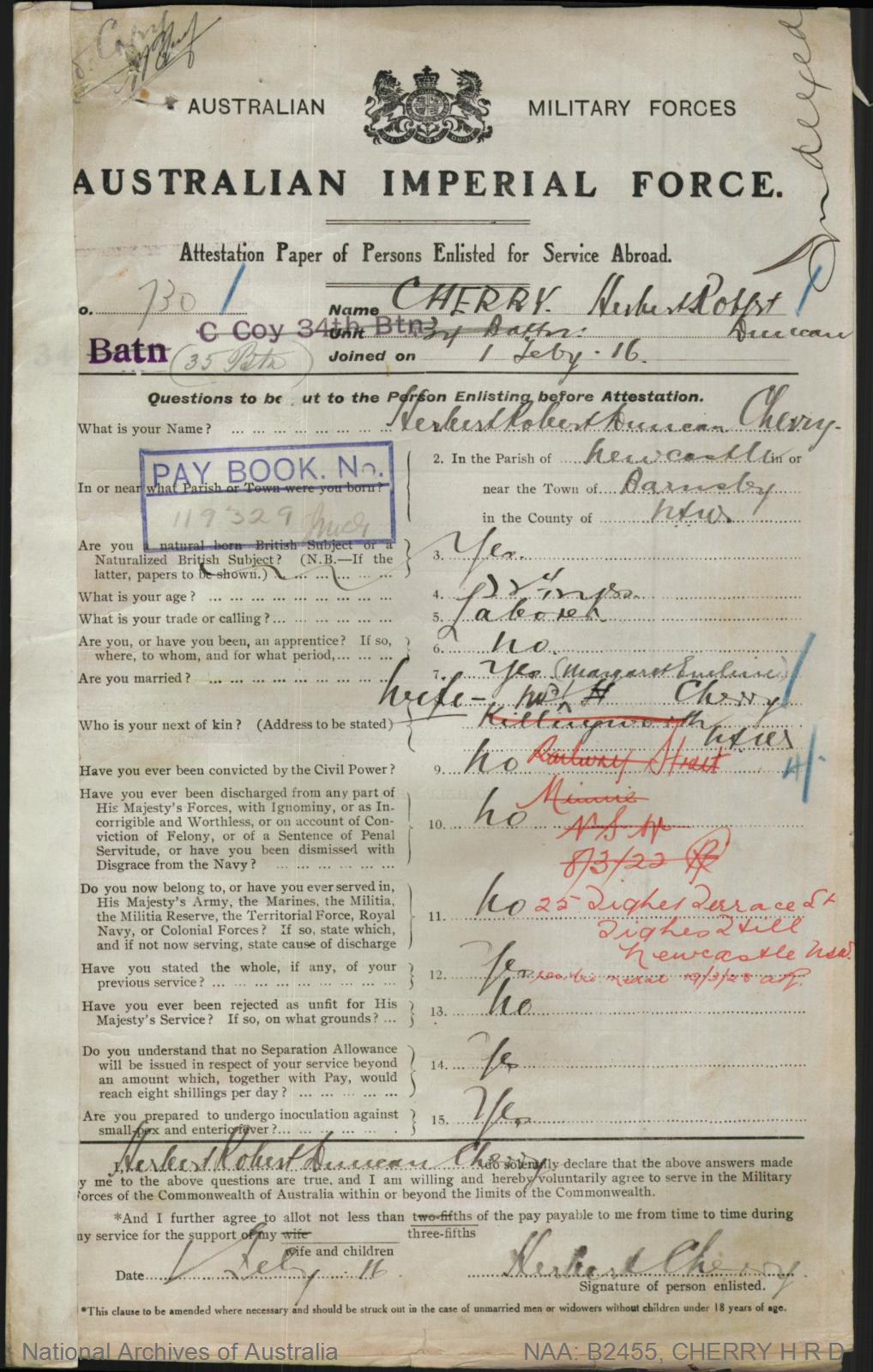
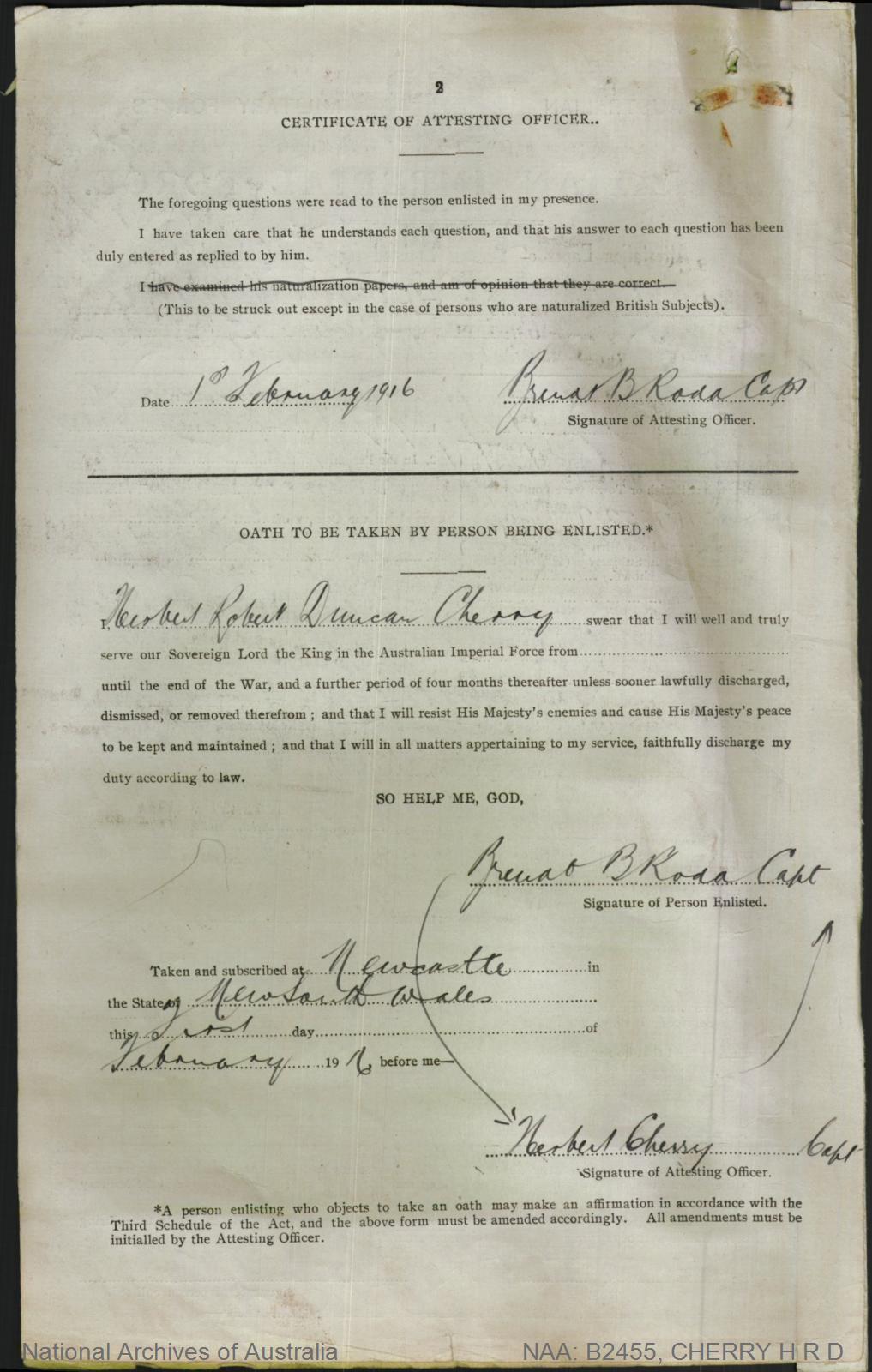
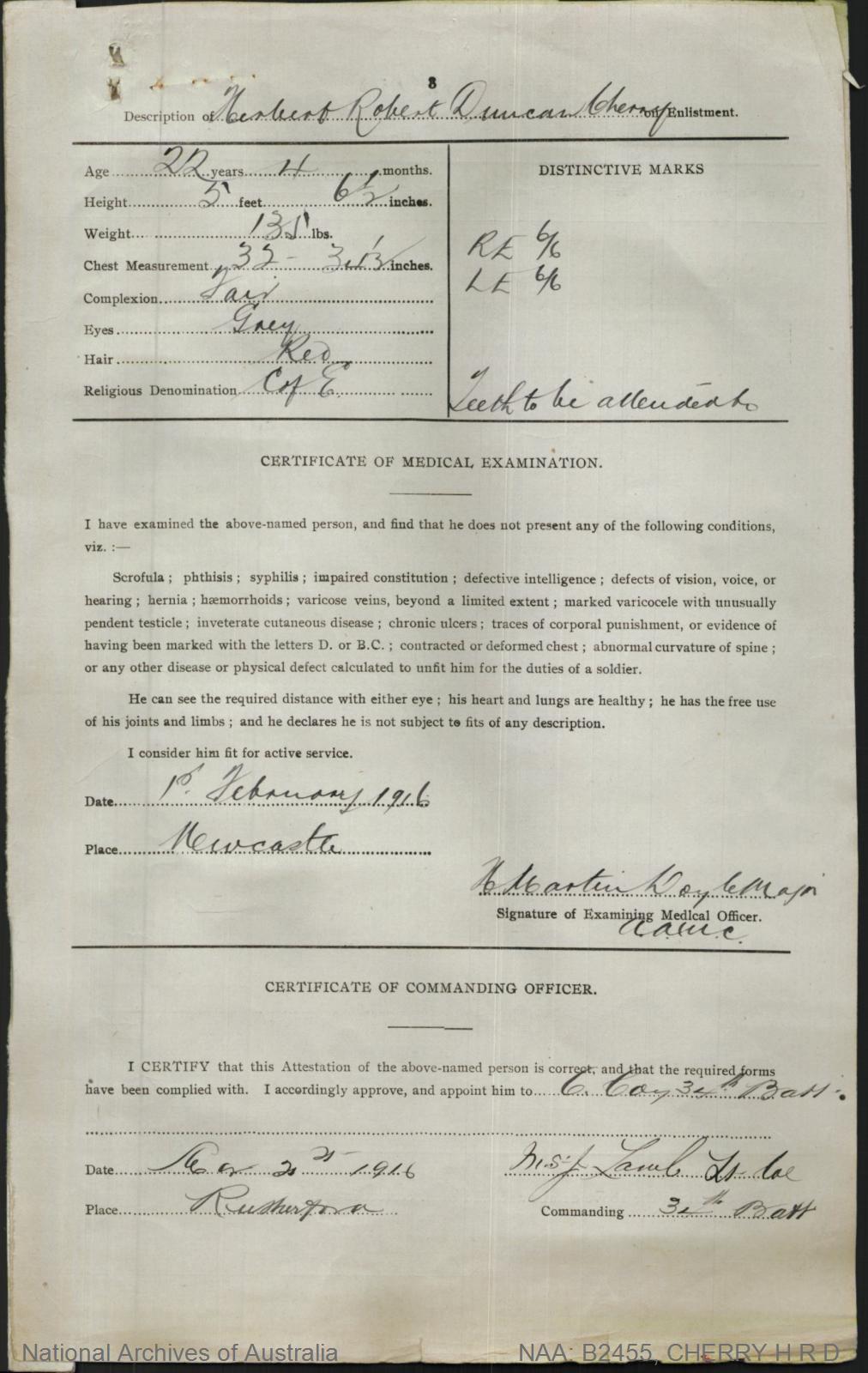
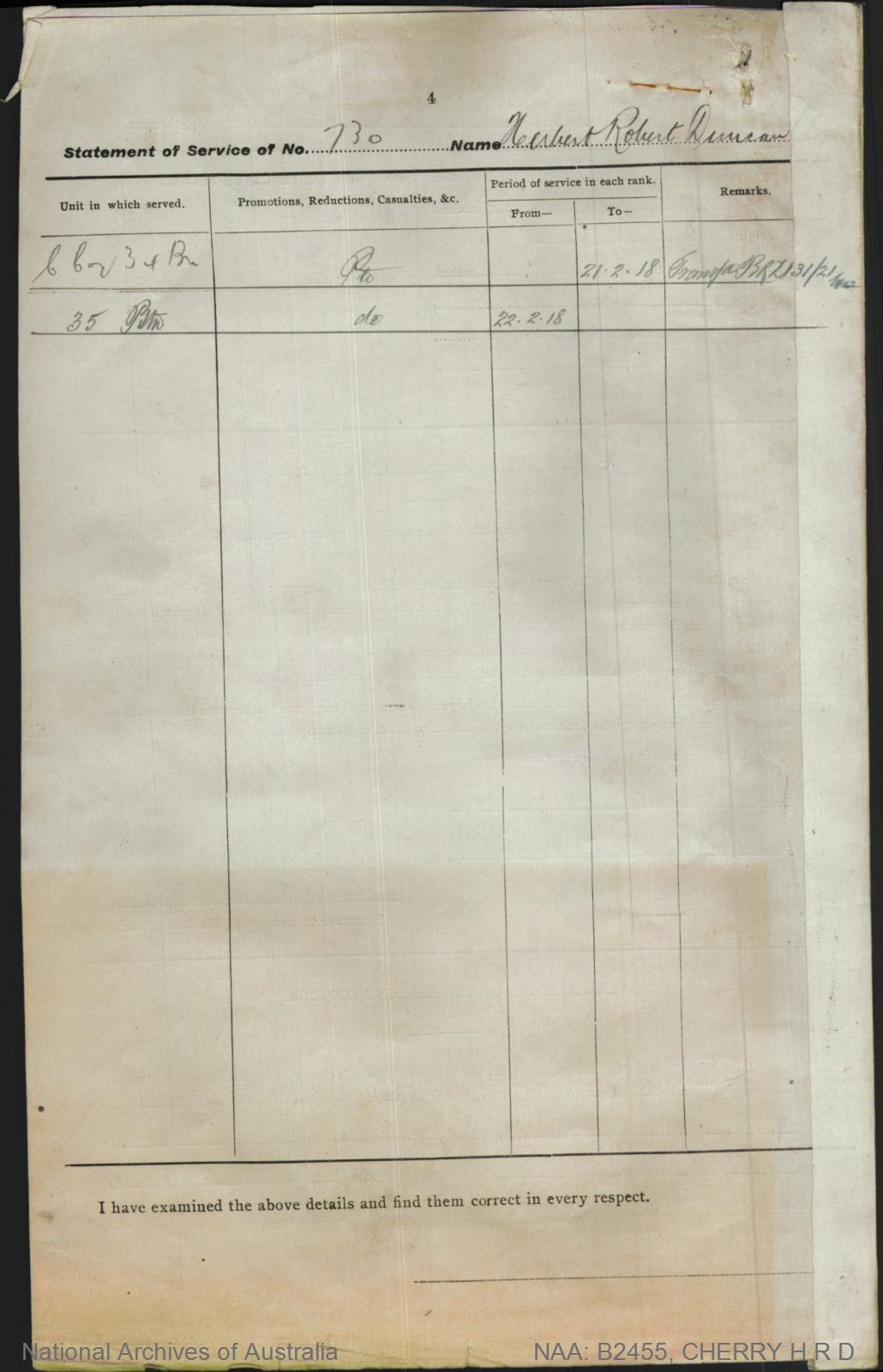

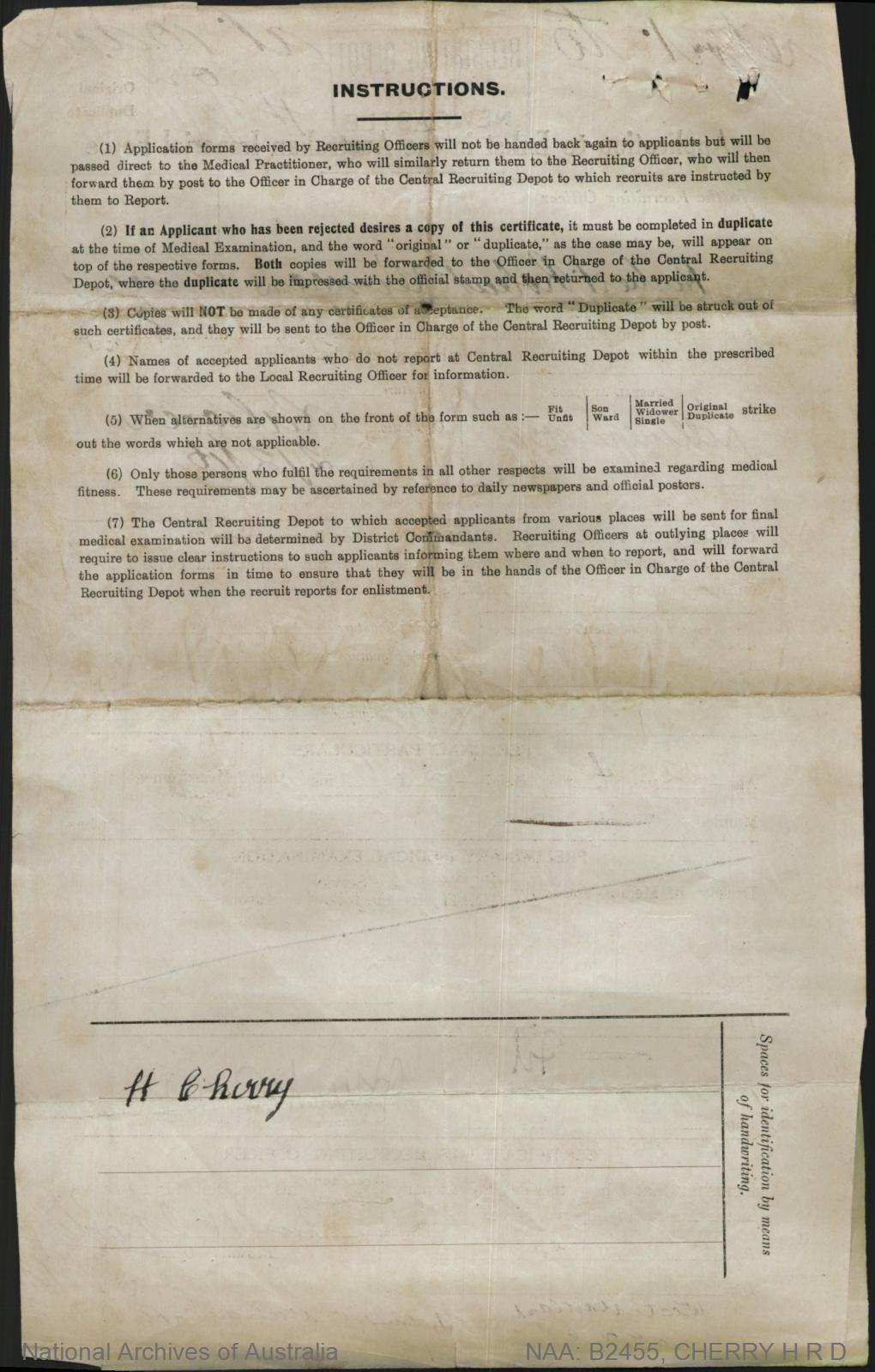
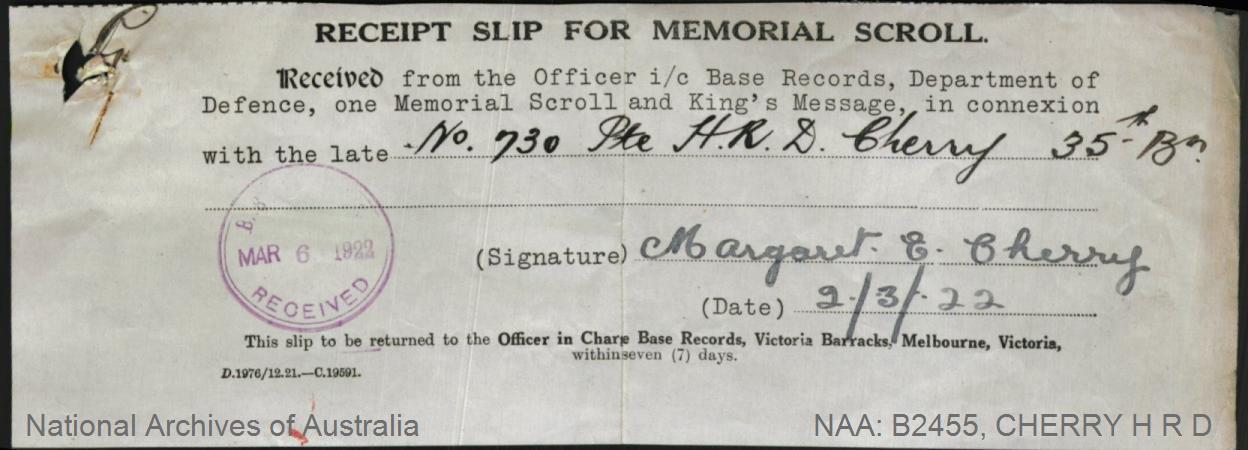
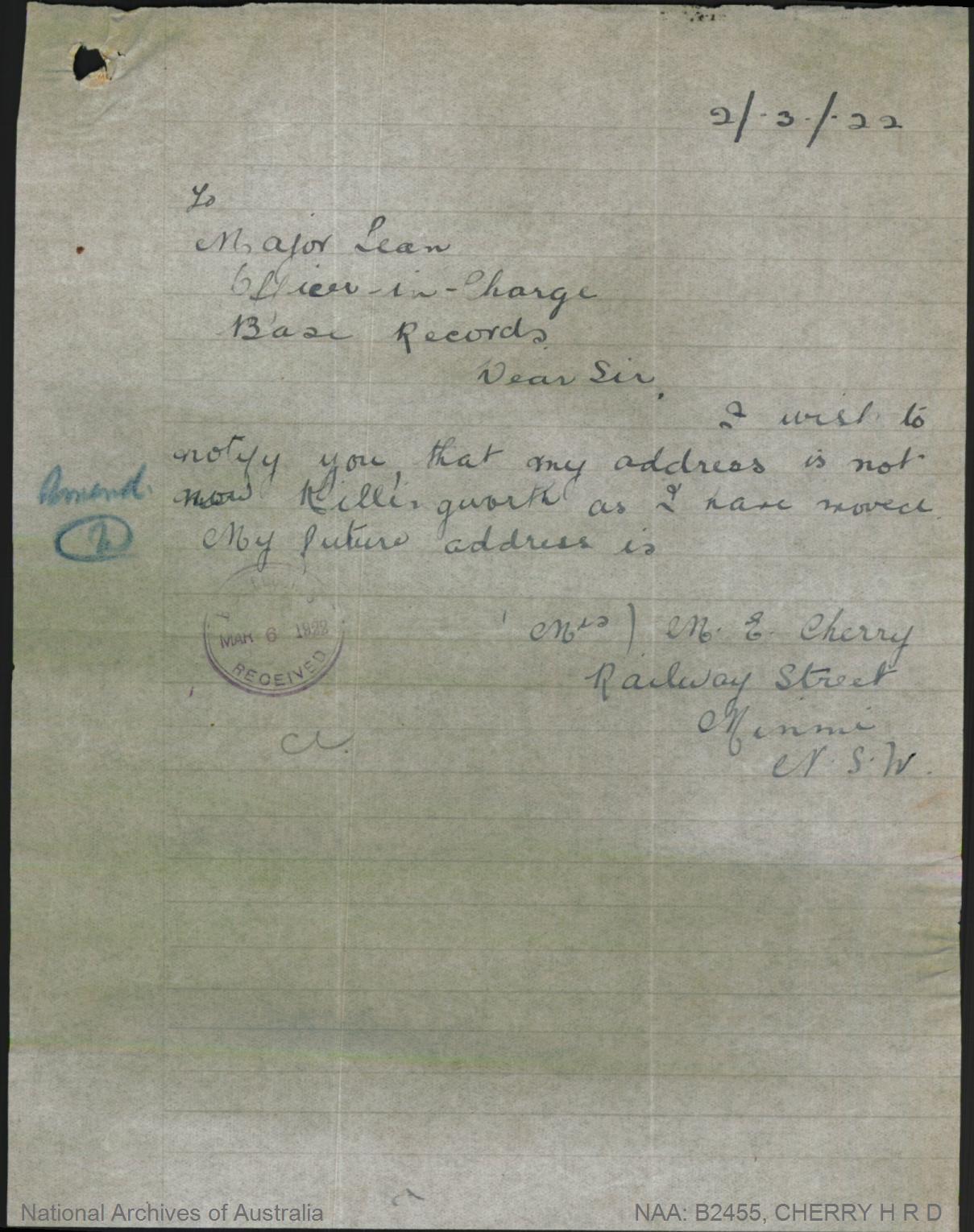
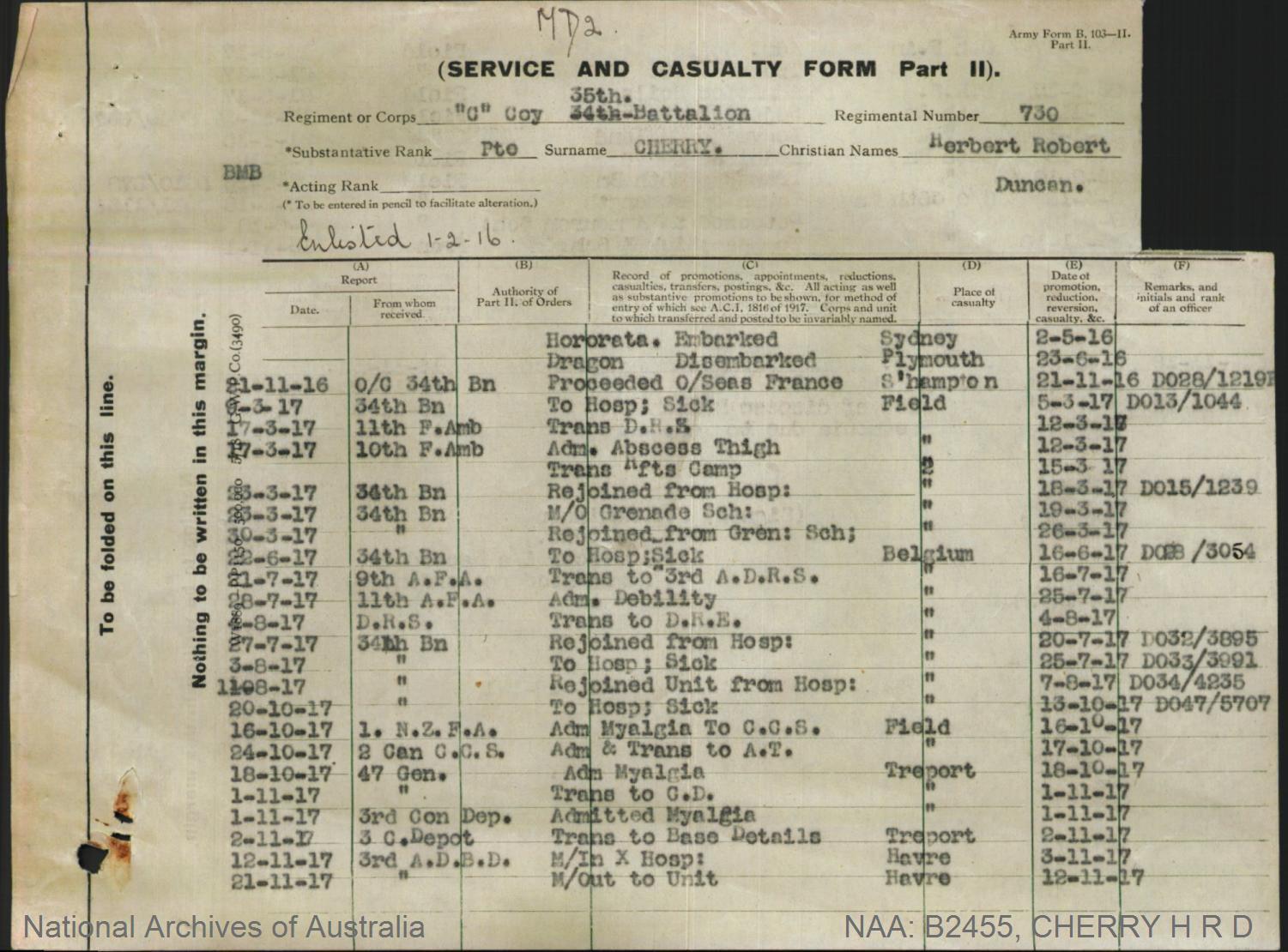
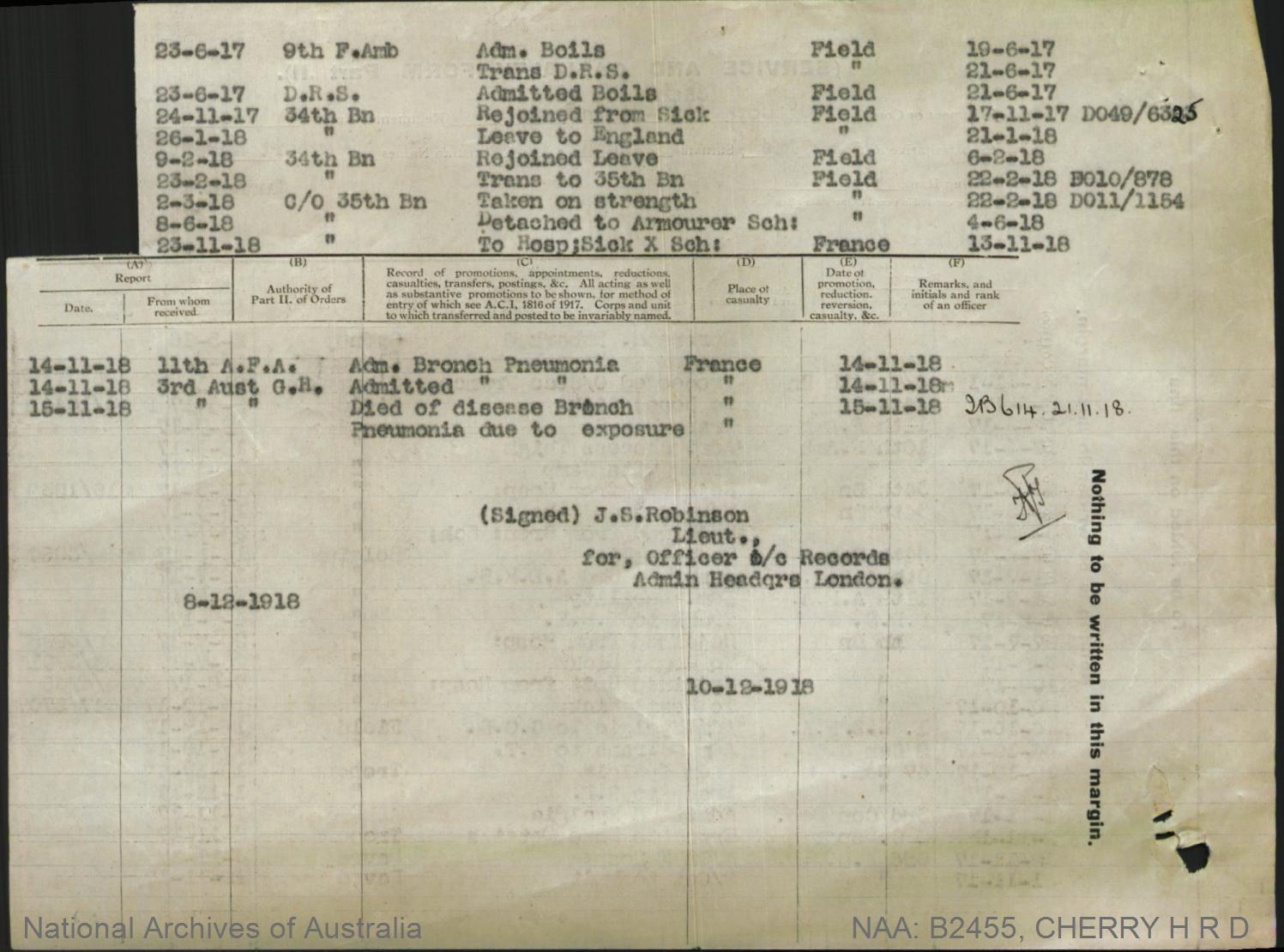
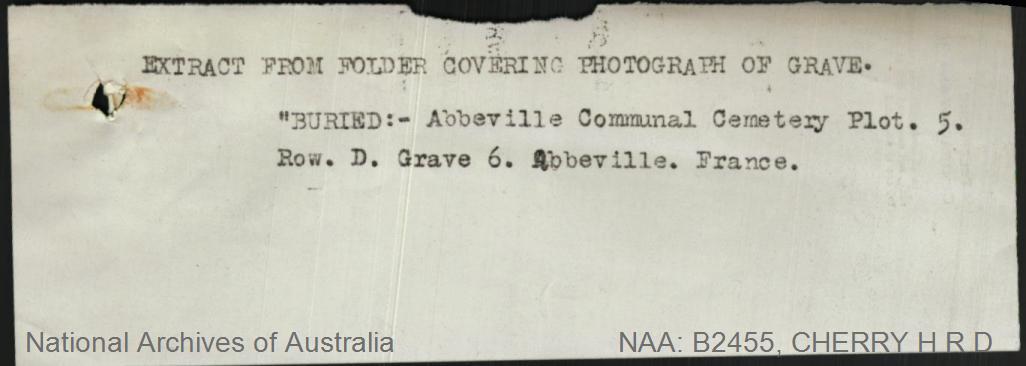
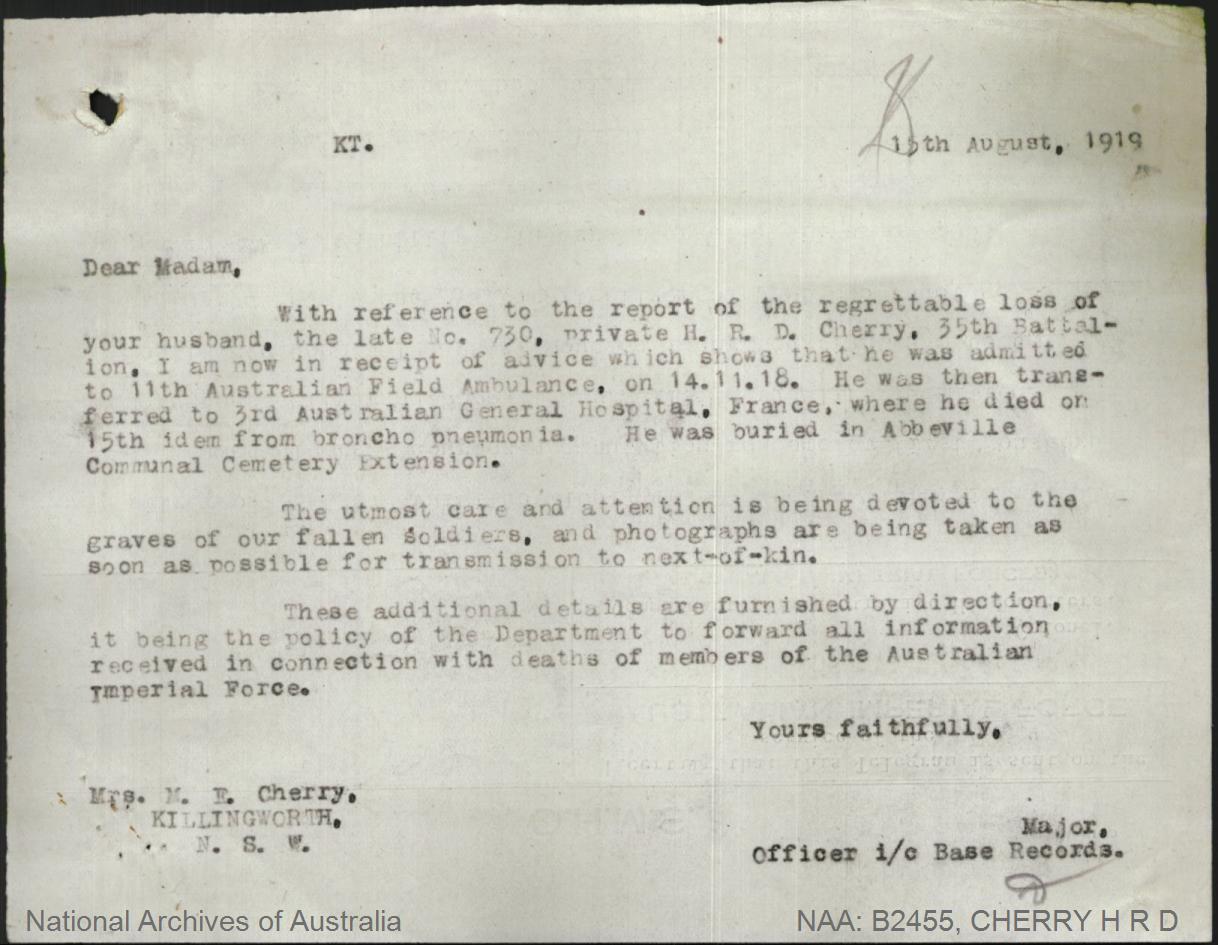
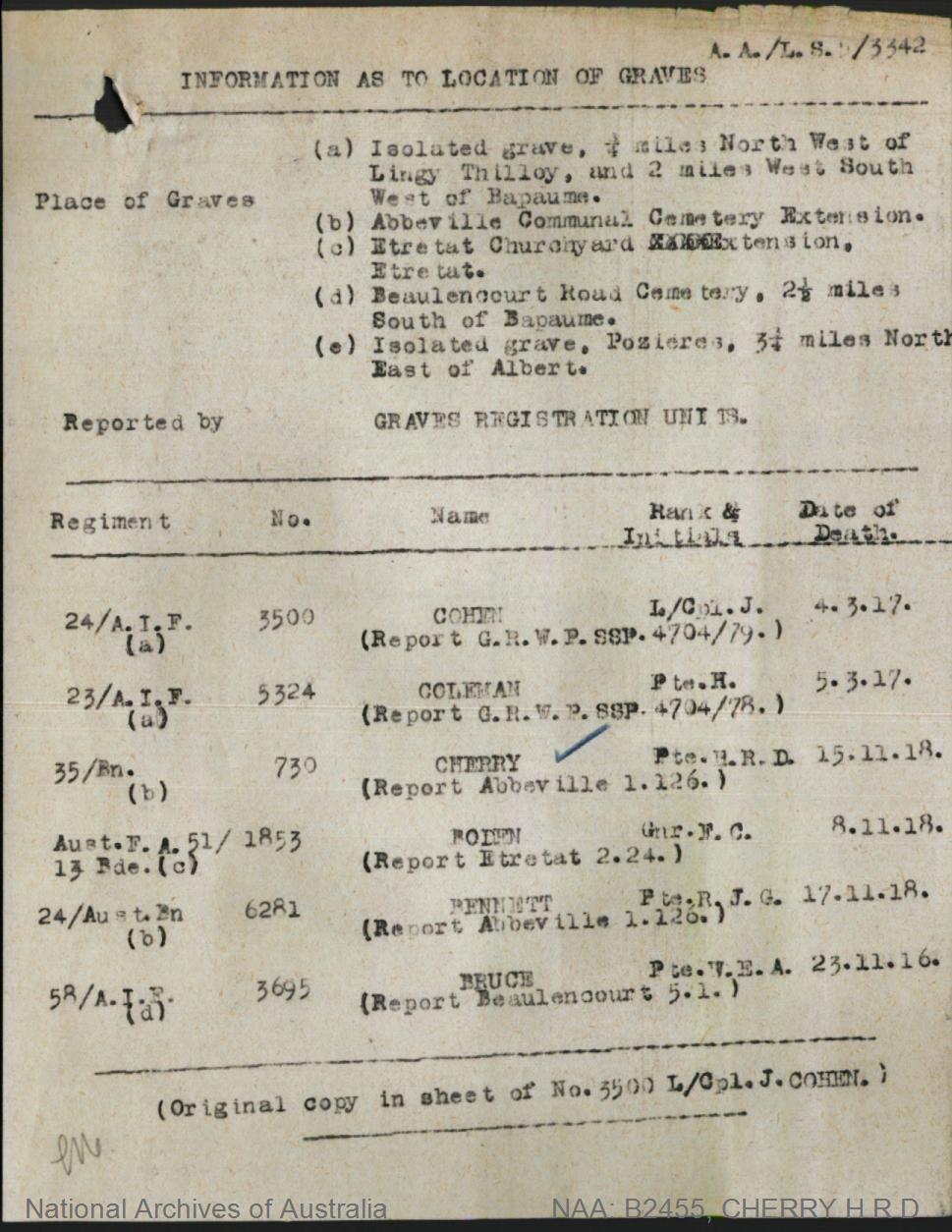


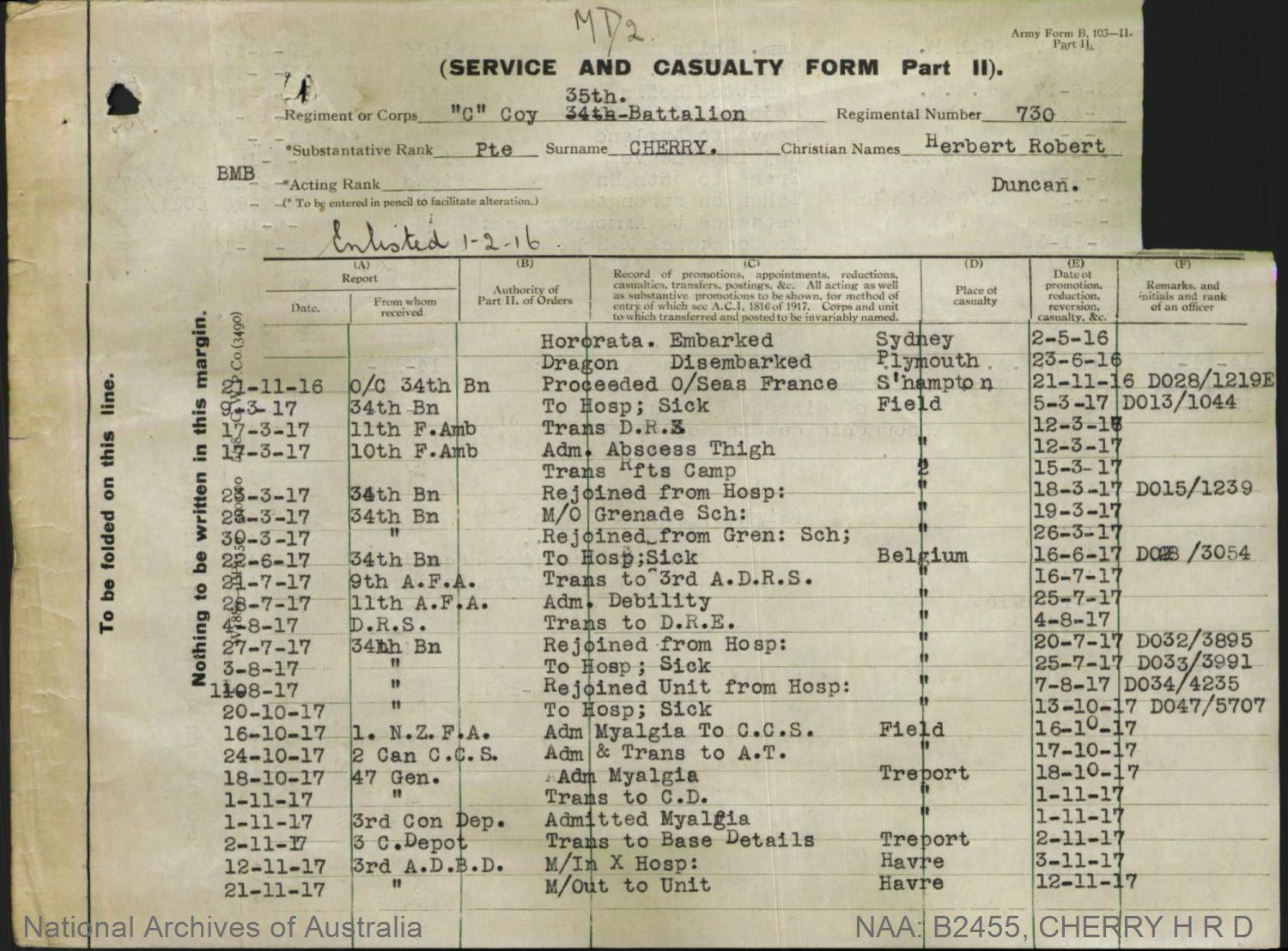
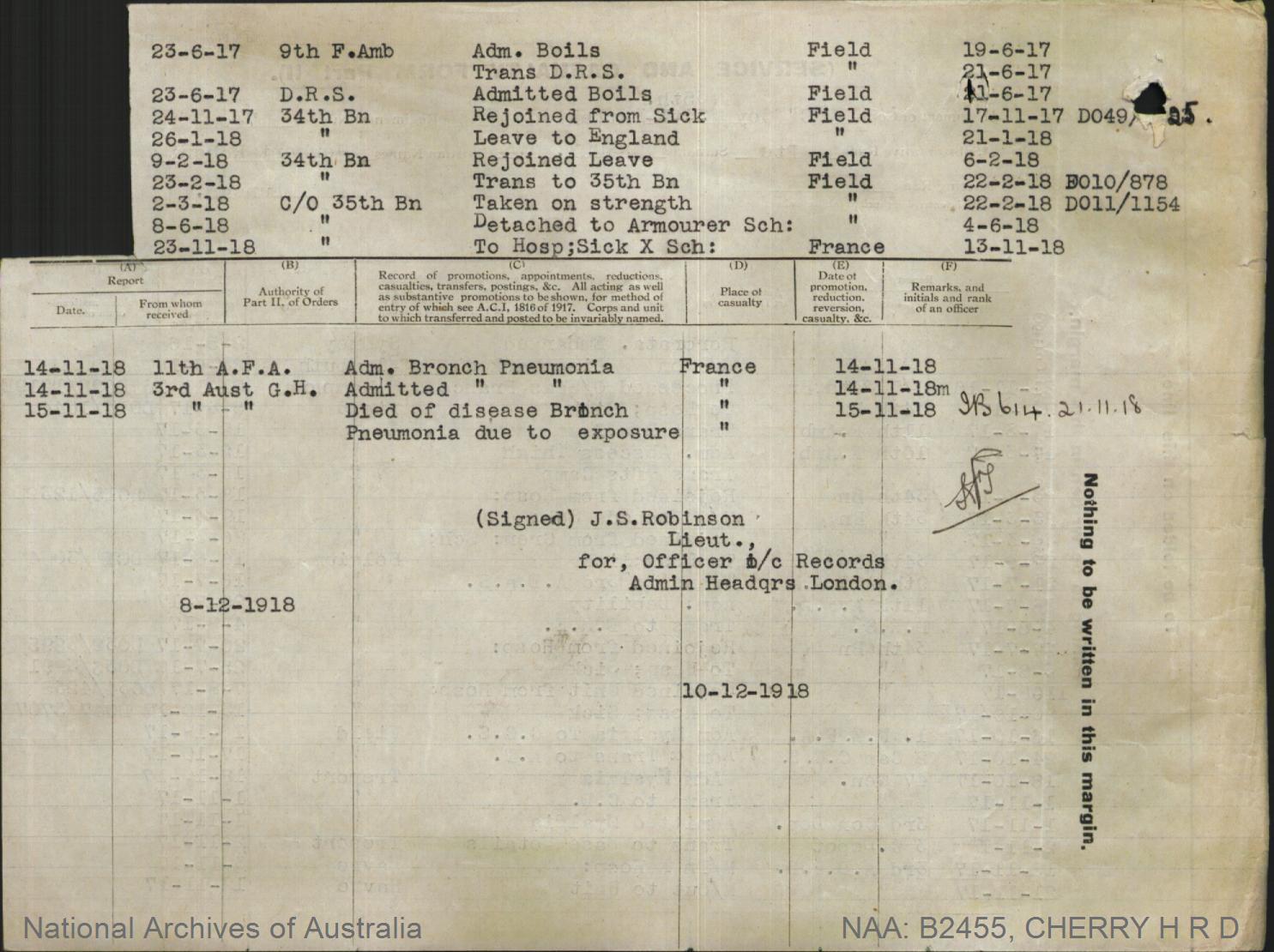
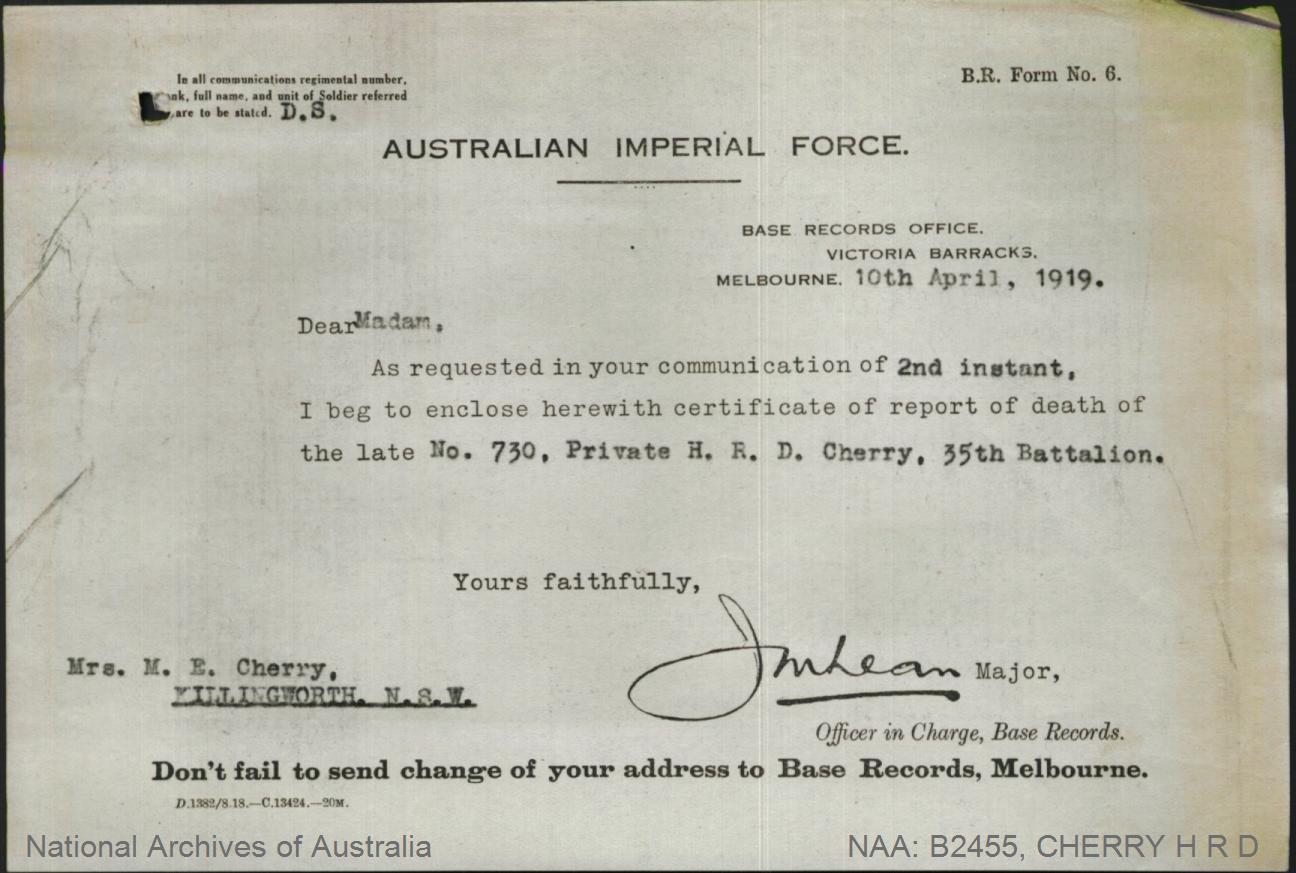

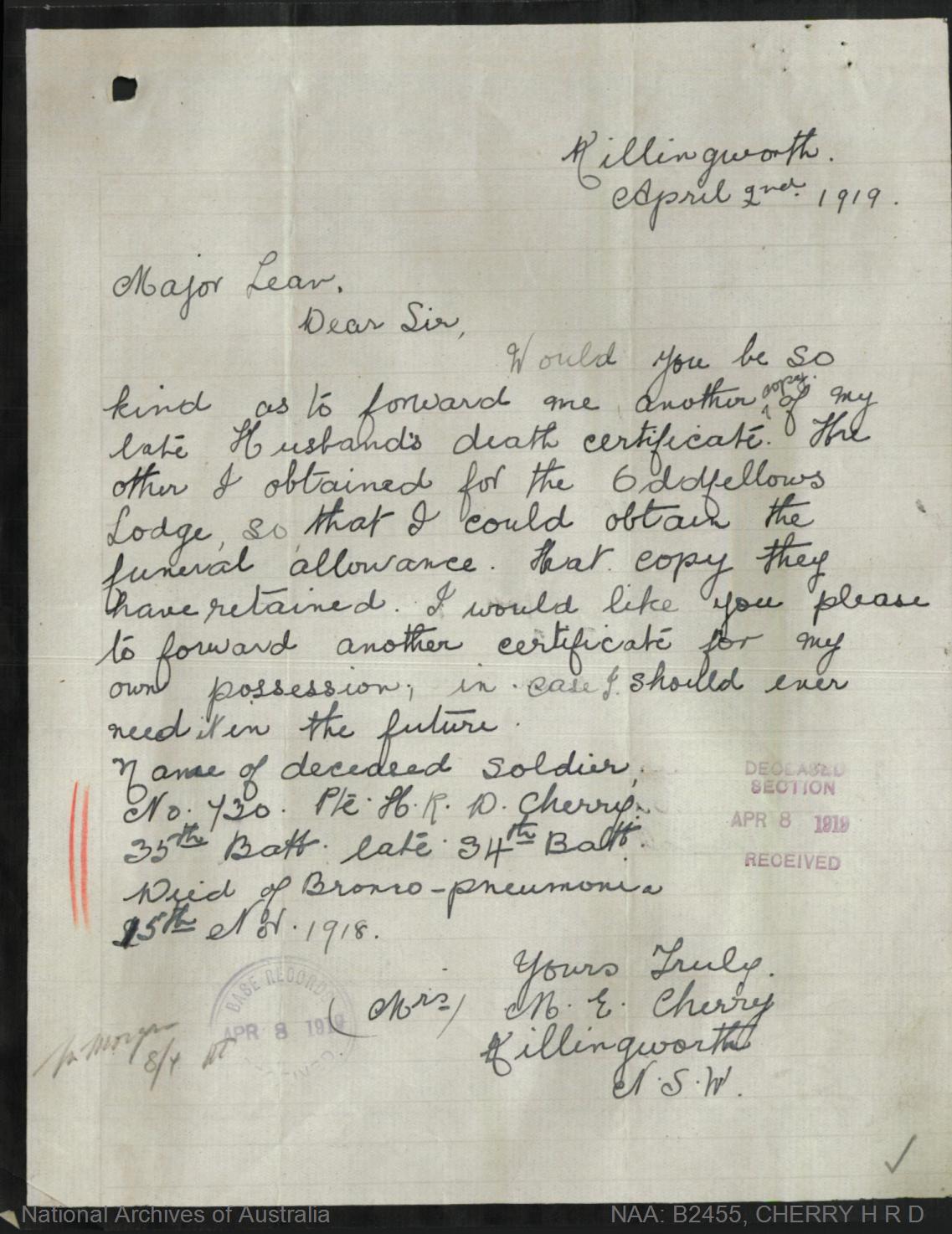
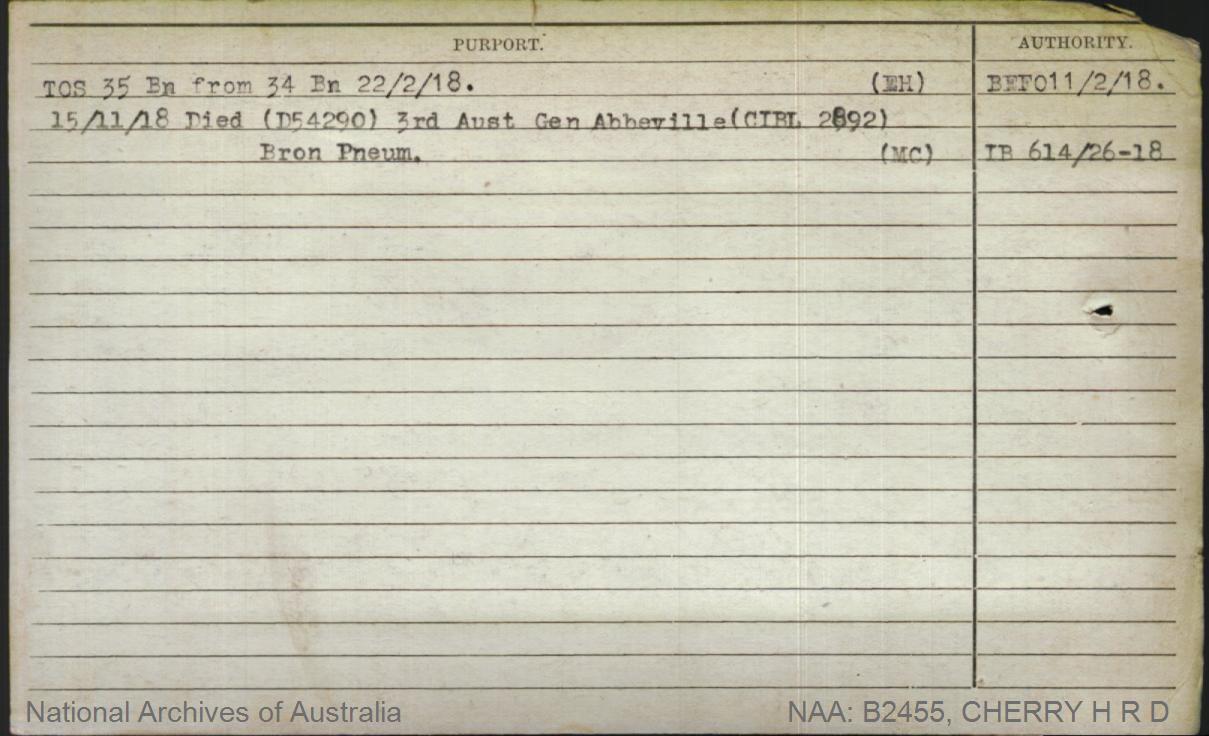
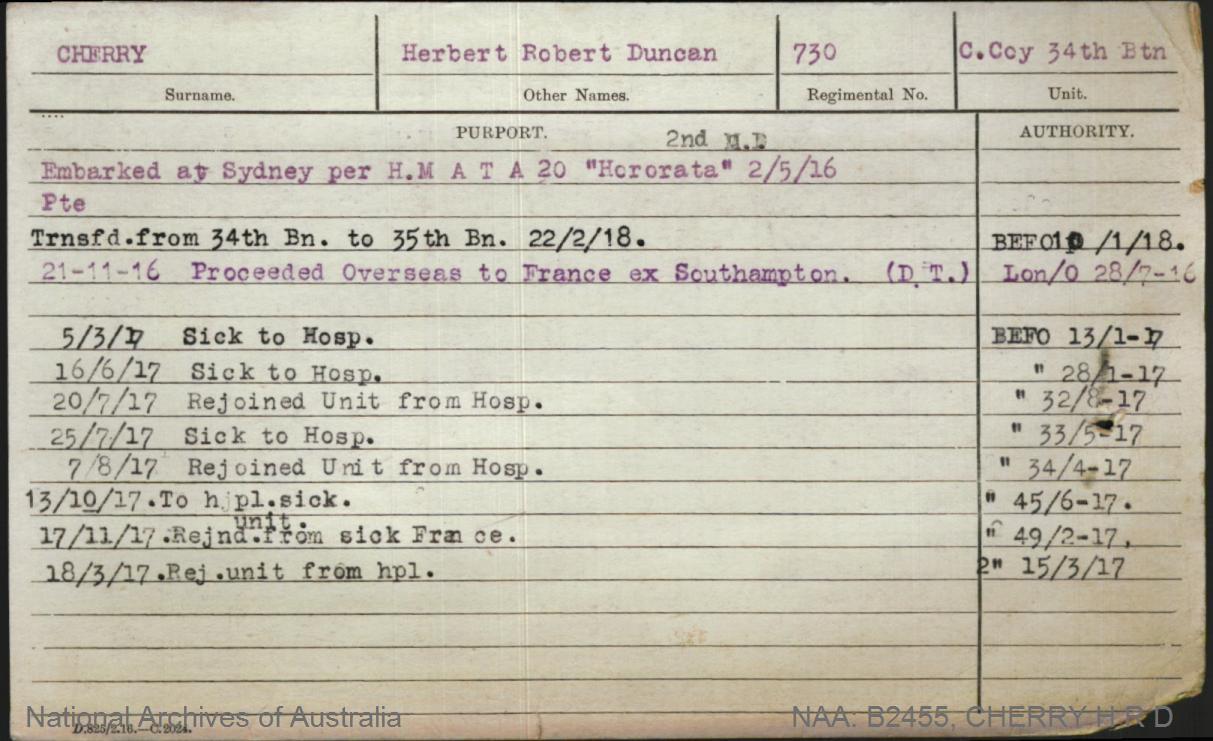


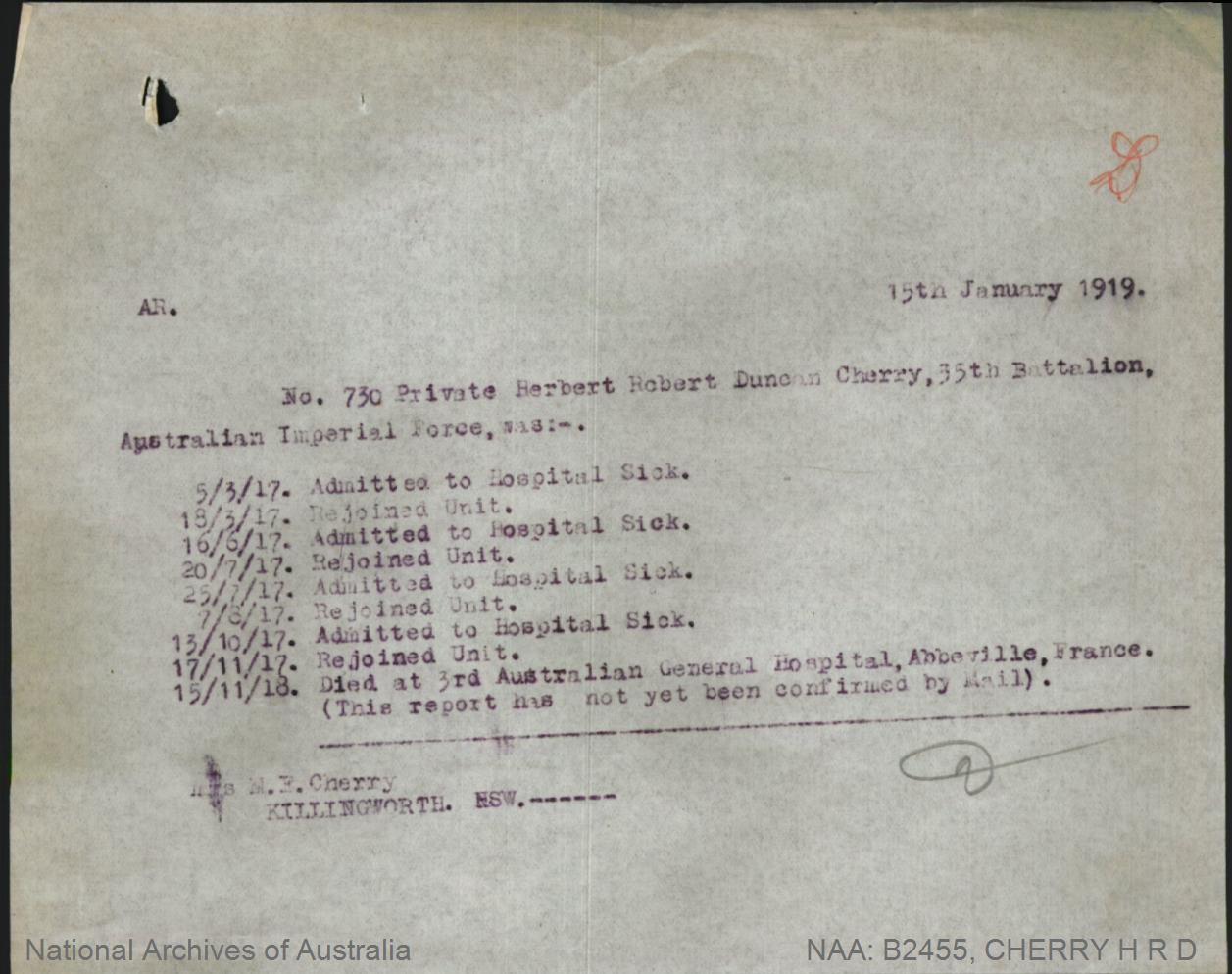
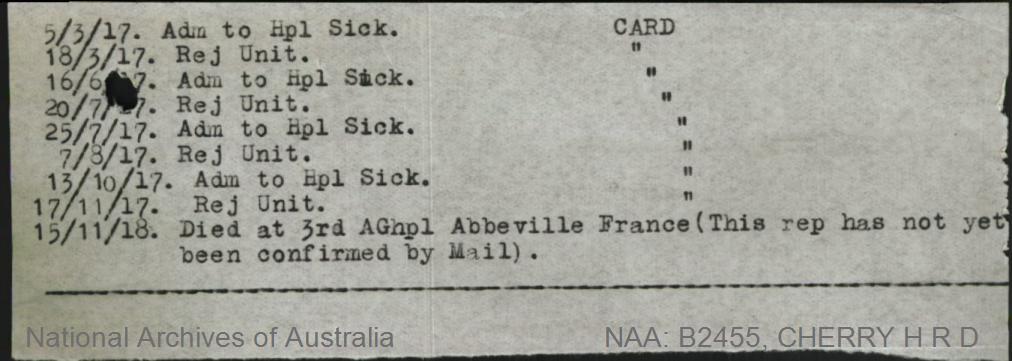
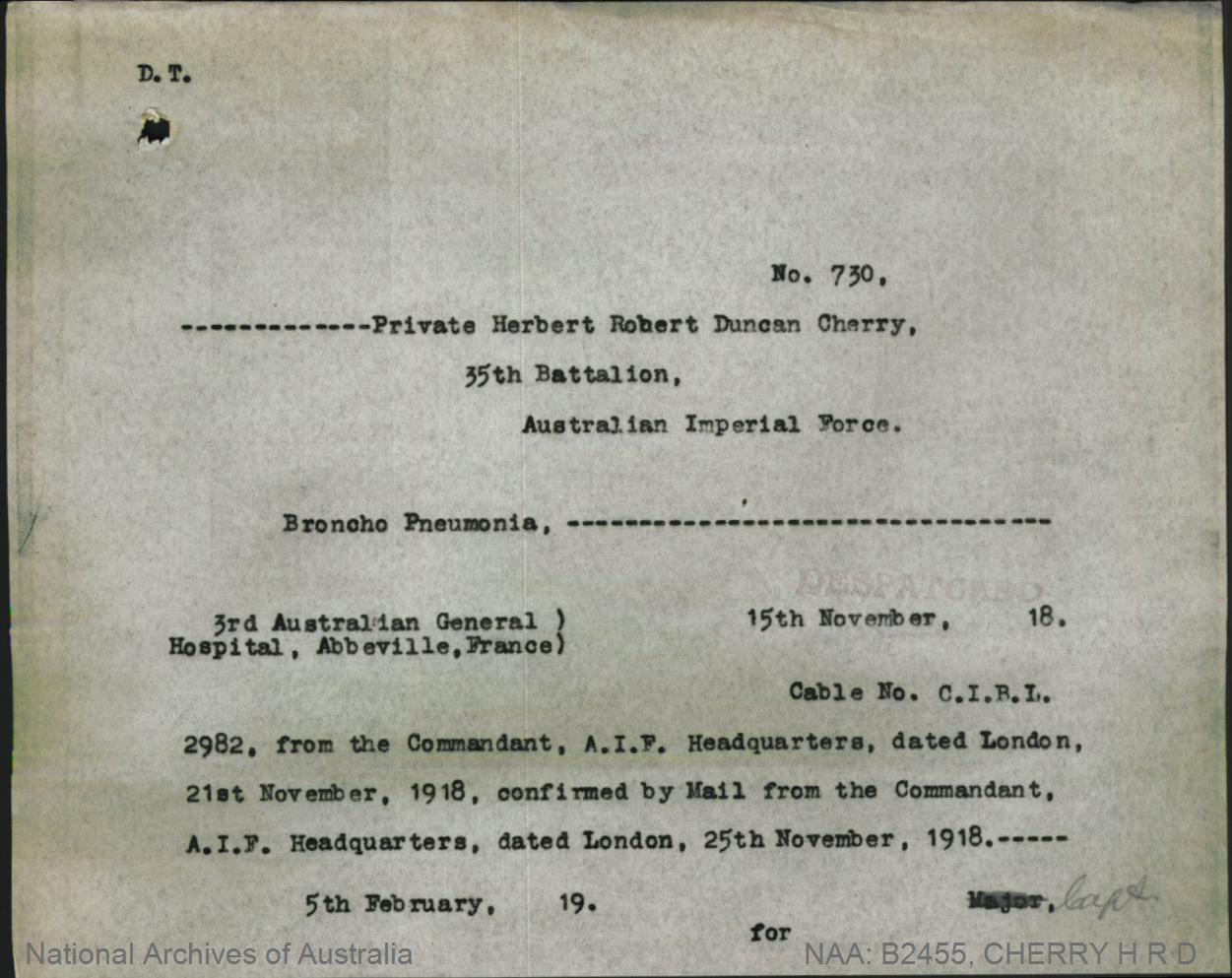

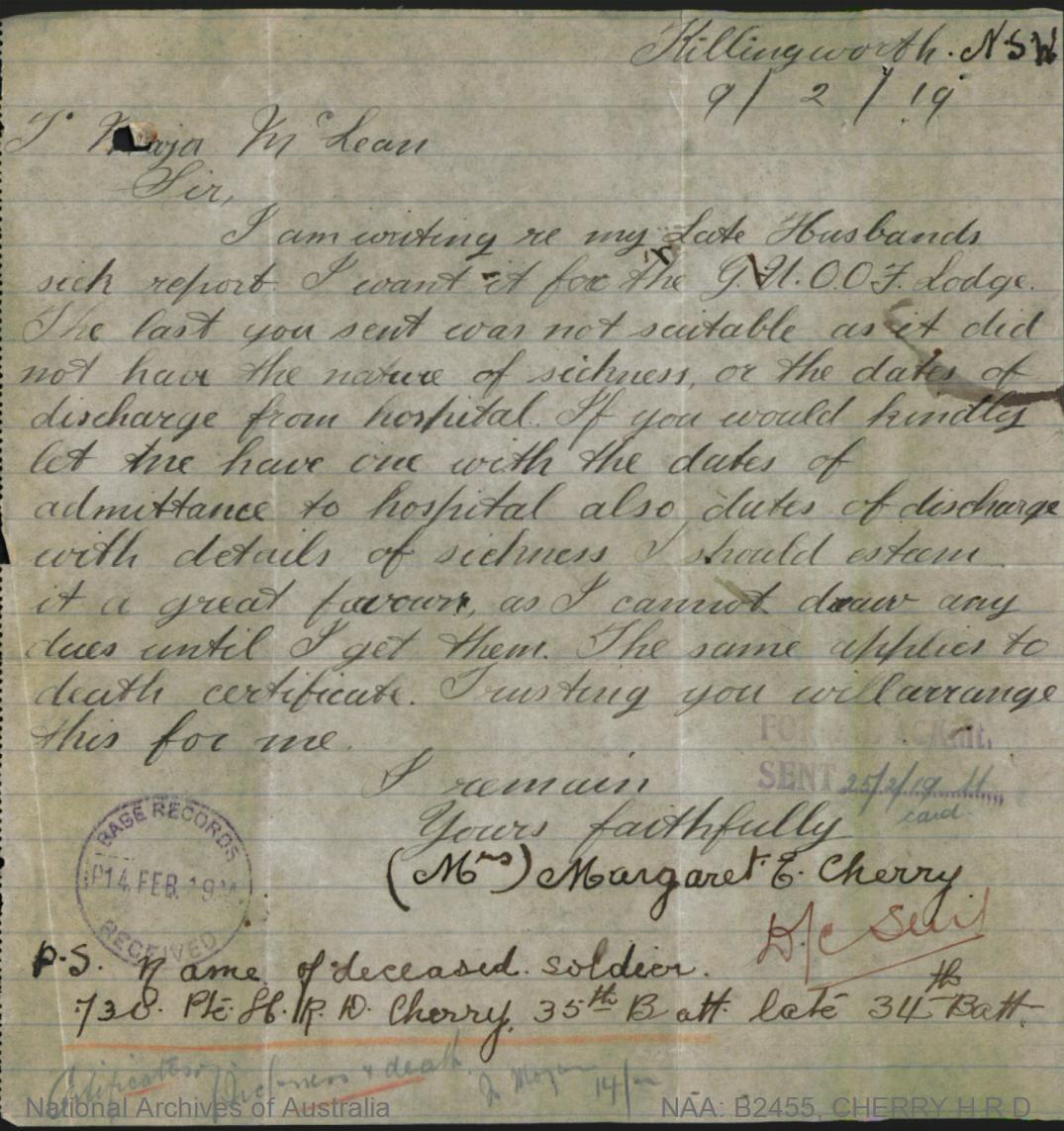
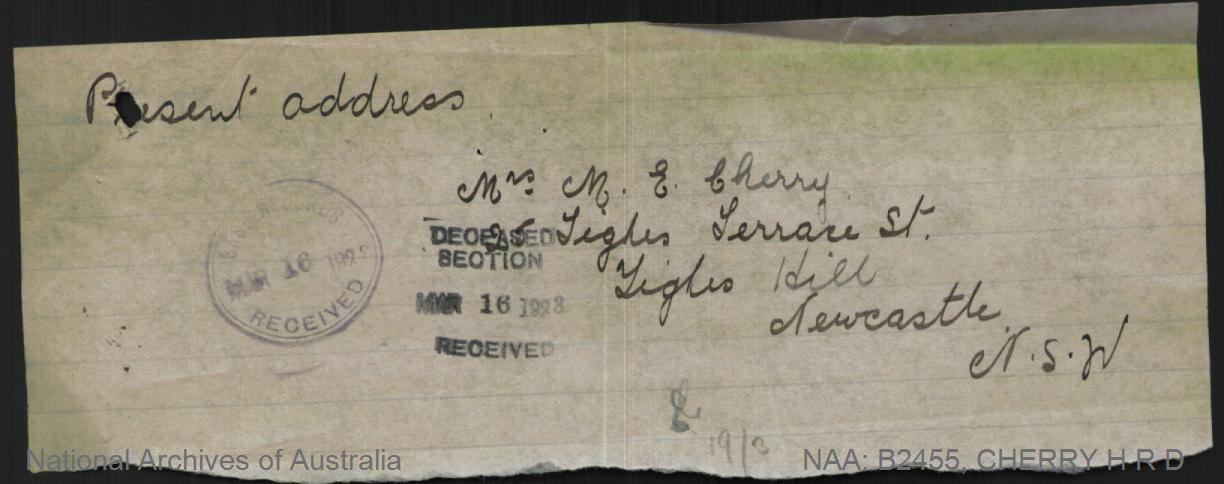
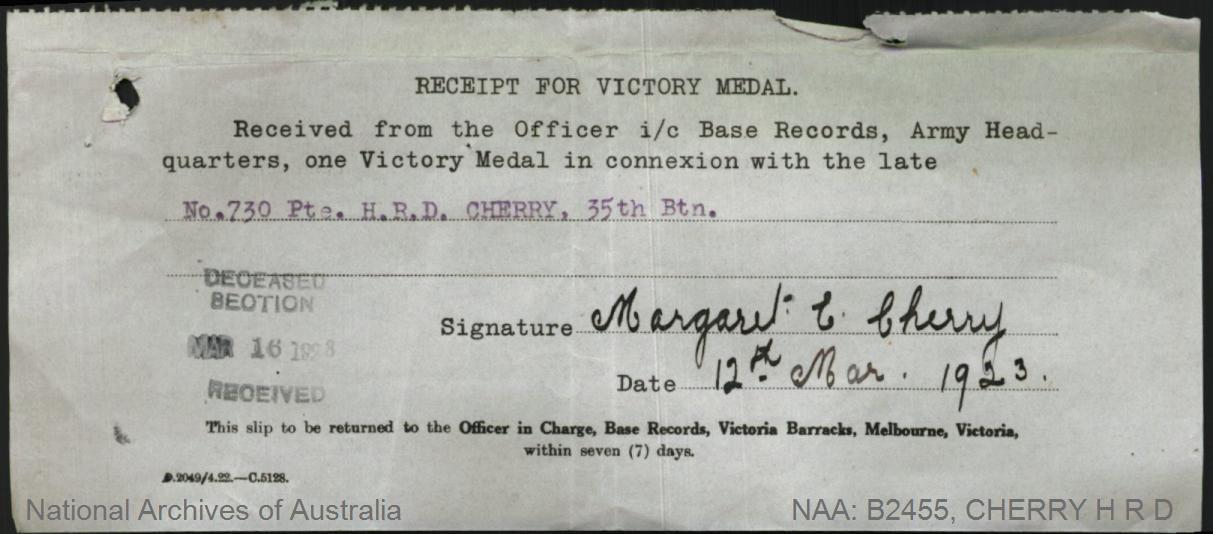
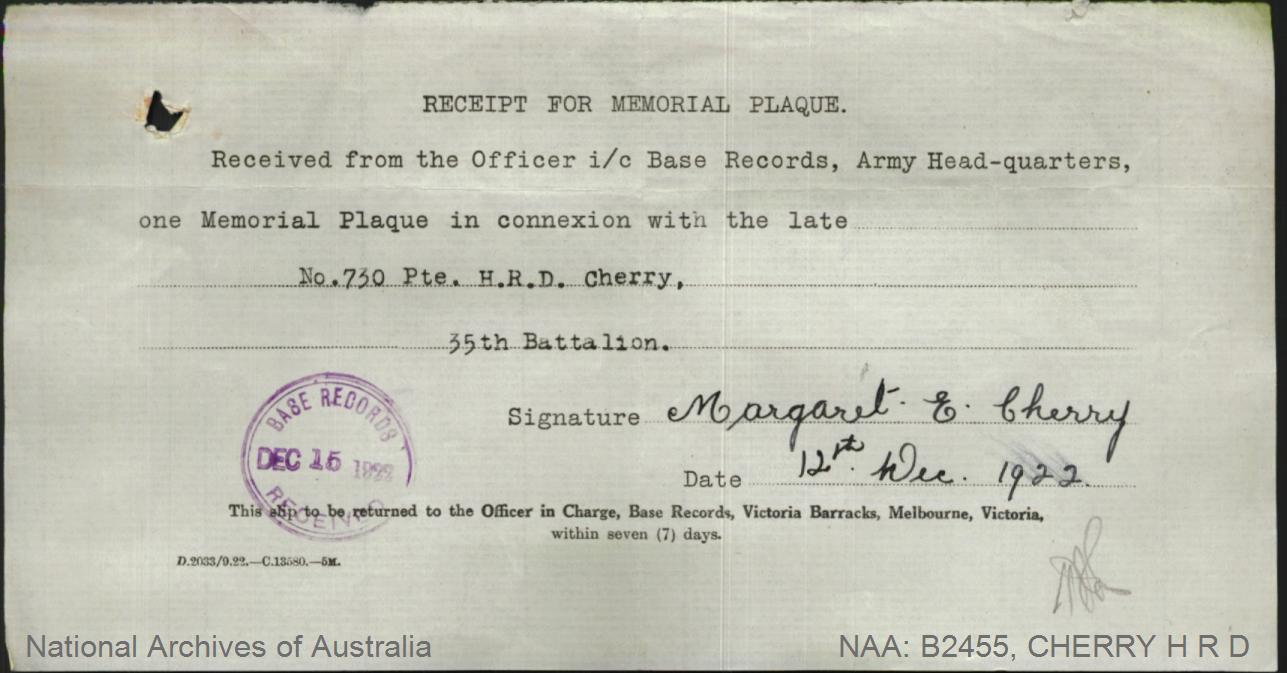
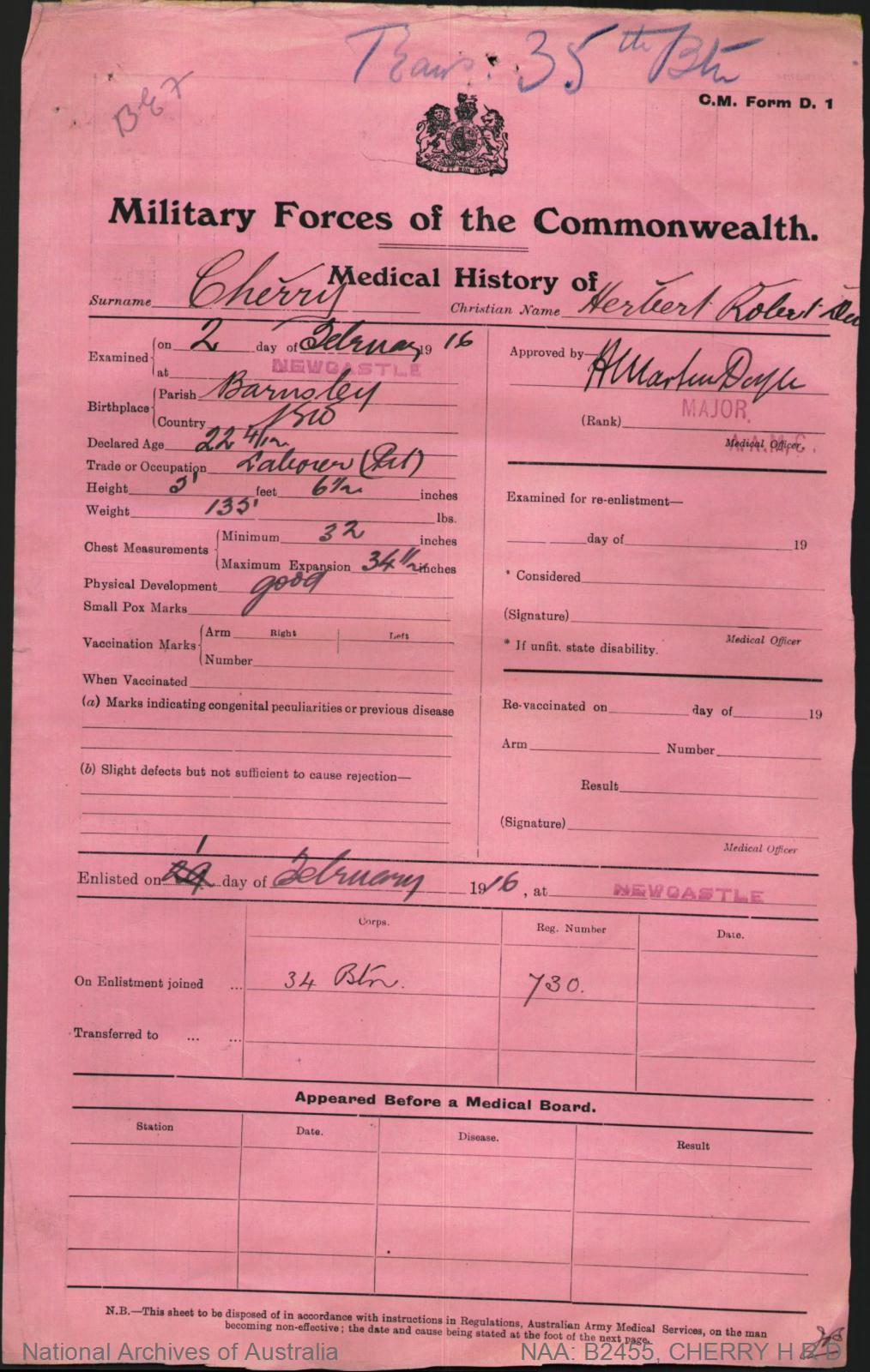
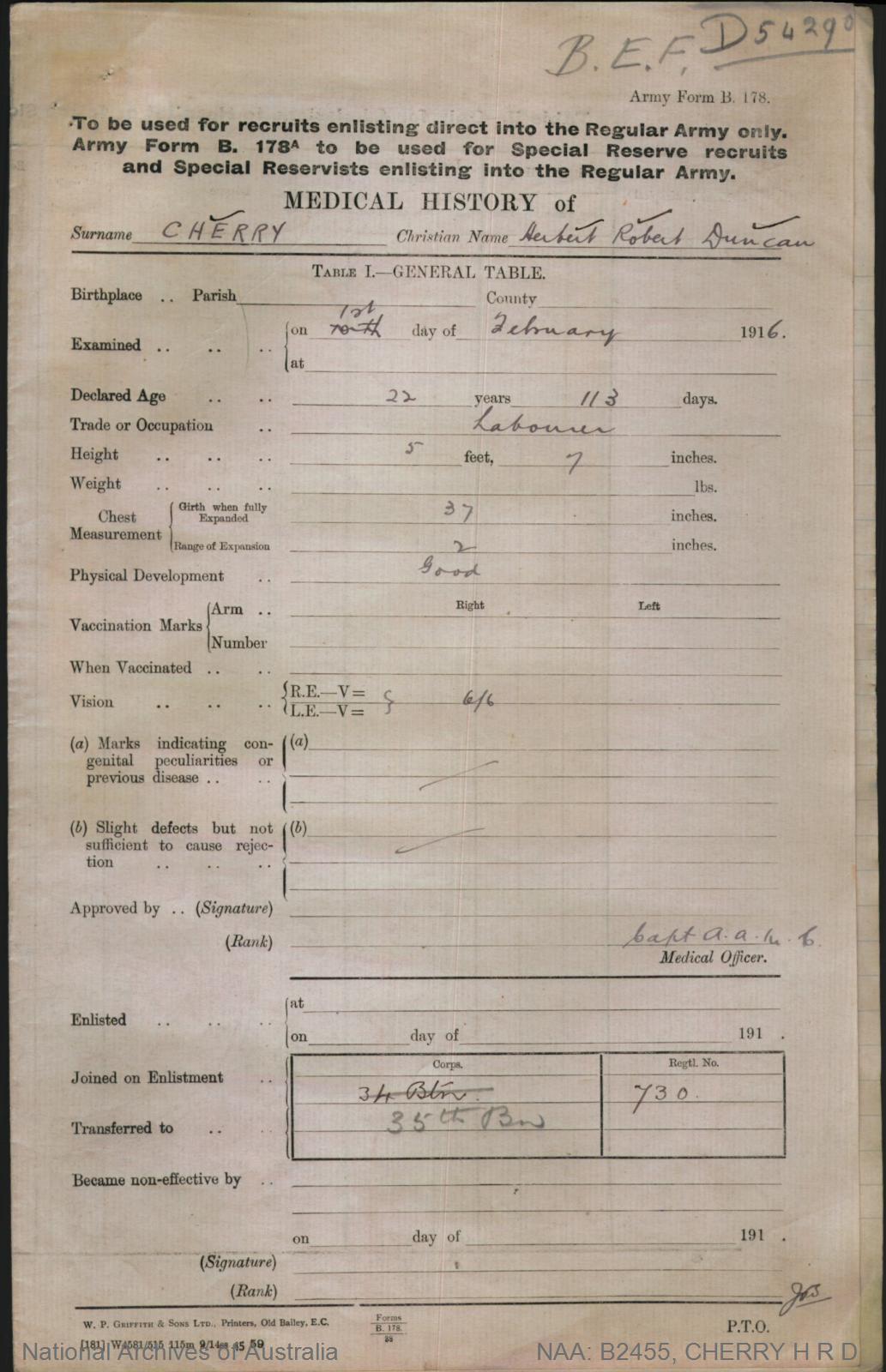
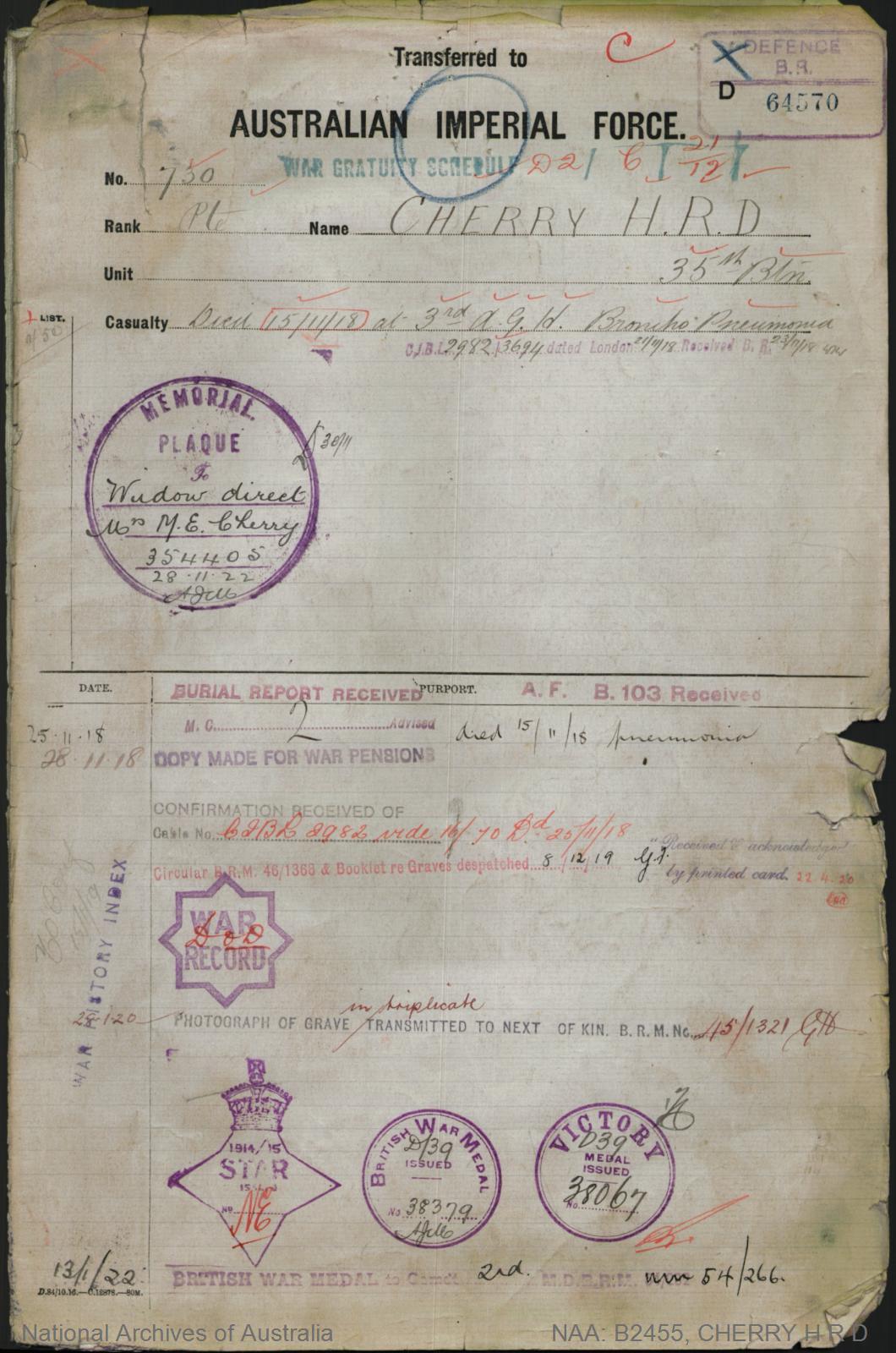

Under Construction: 04/01/2023.
